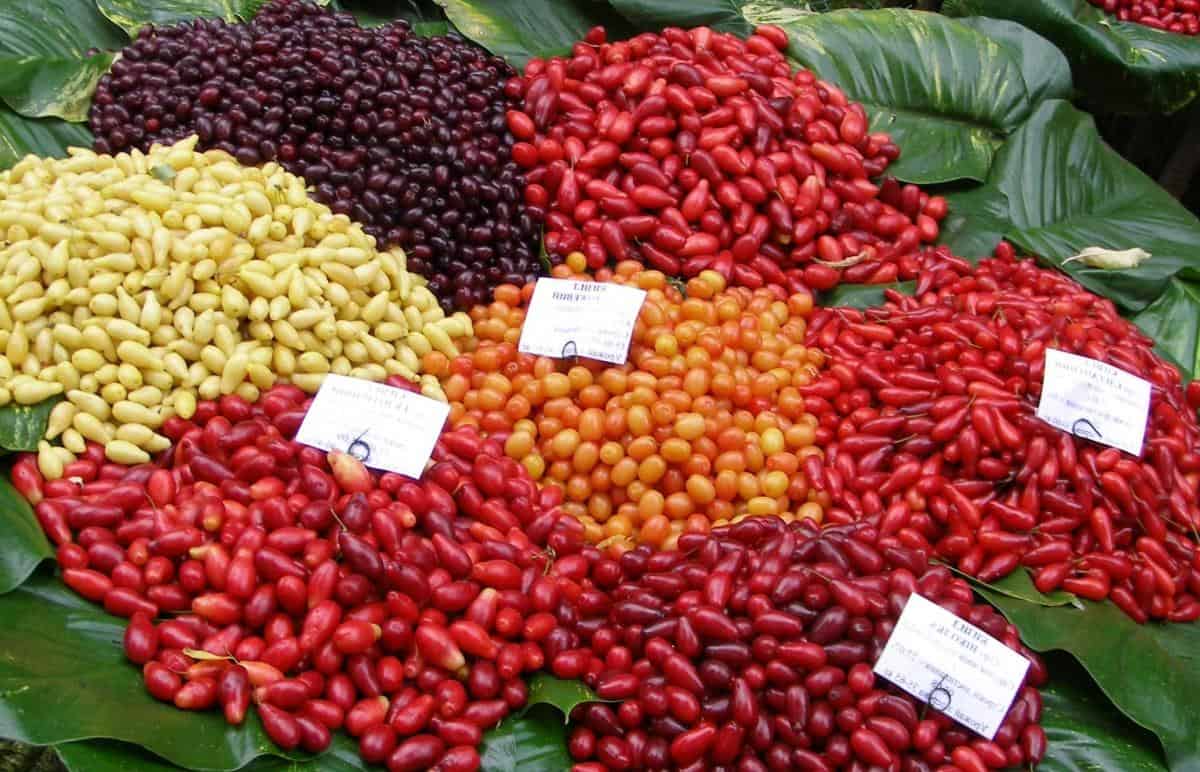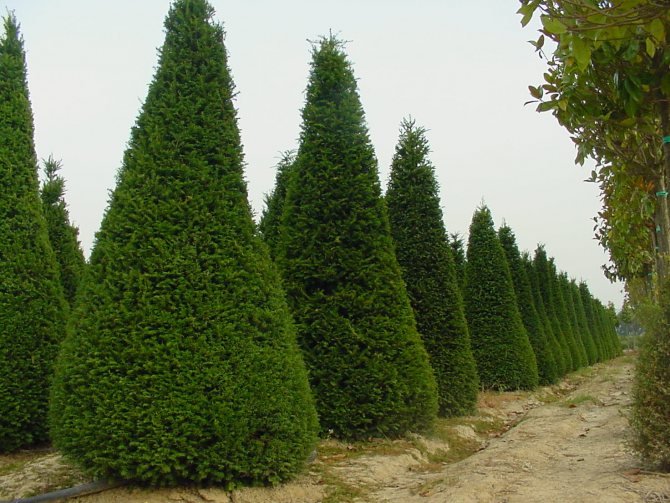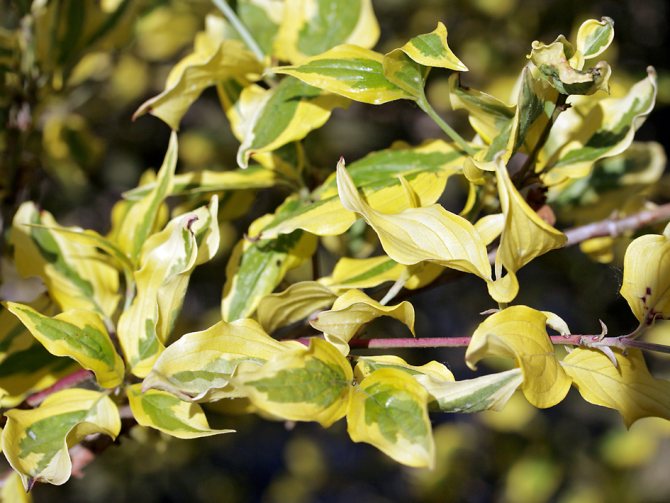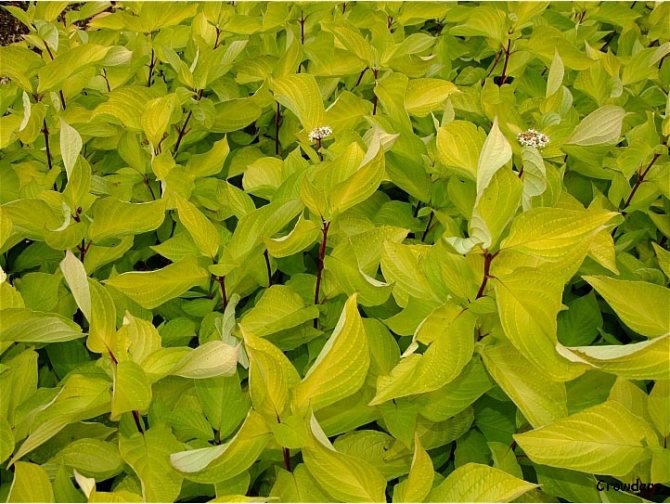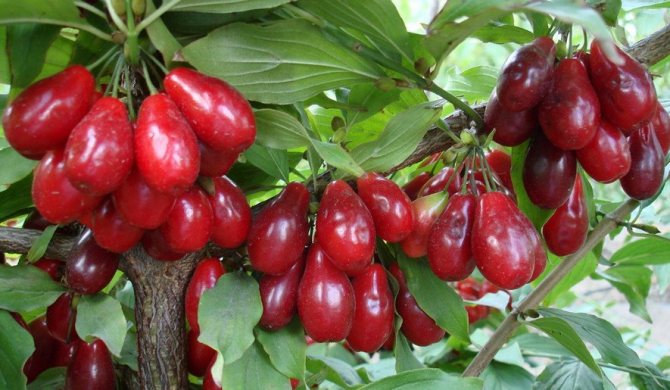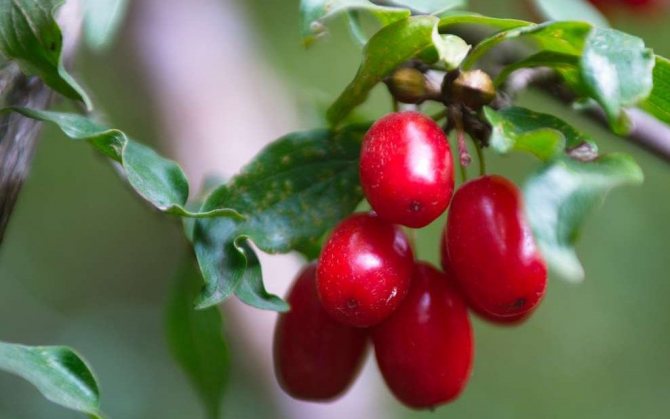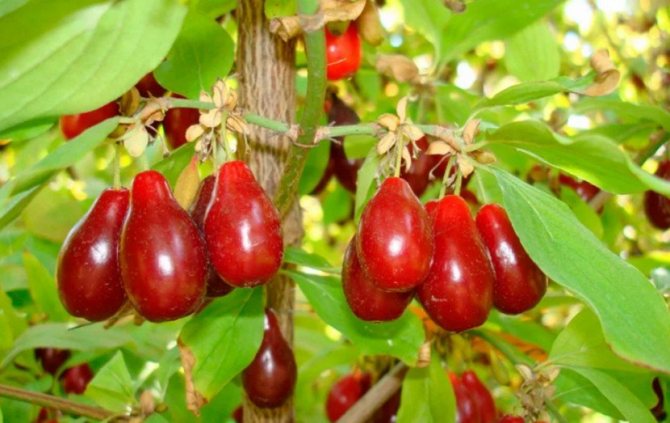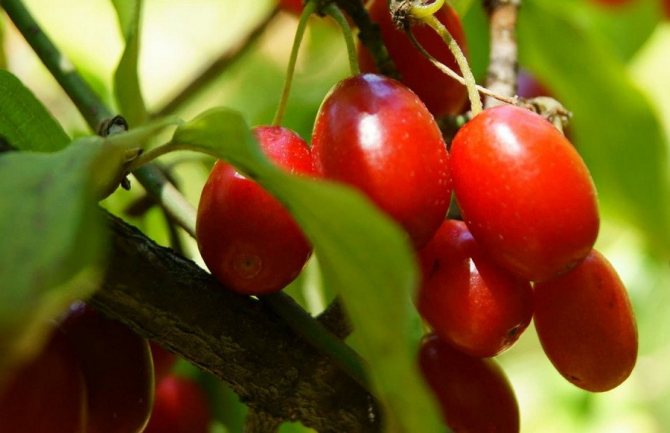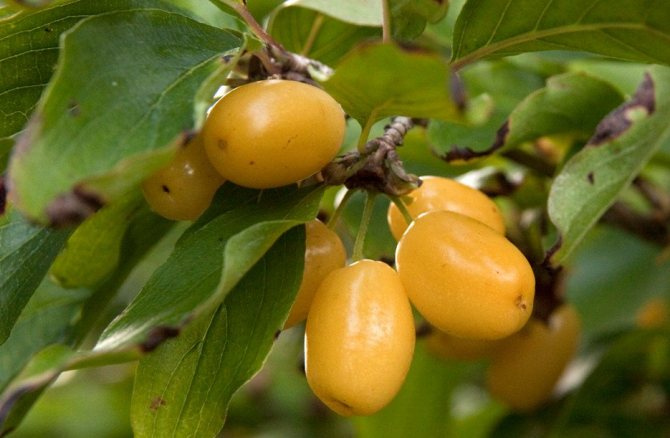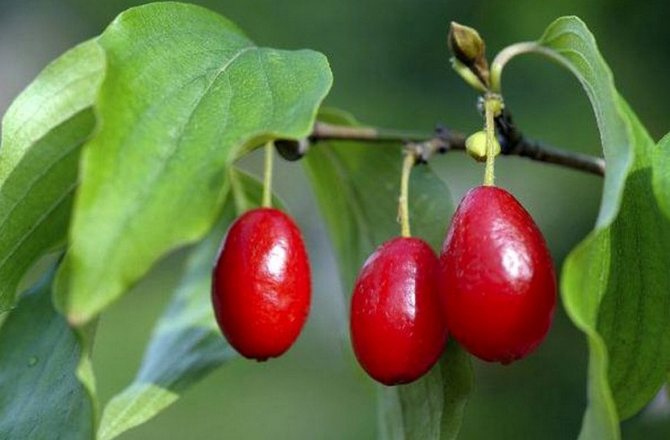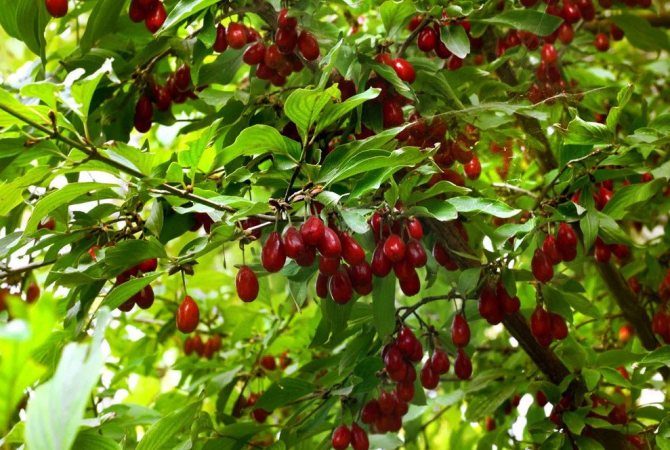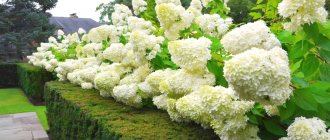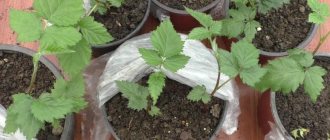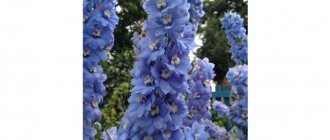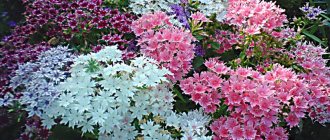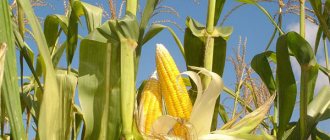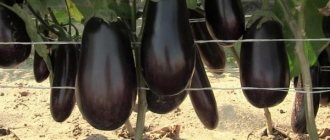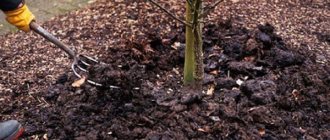
Cornel is a frost and drought-resistant shrub that does not impose special requirements on the condition of the soil. Cornel has a lot of useful qualities and properties, for example, they are successfully treated for hemorrhoids (forgive me for such details on the dacha site), both dried and jam from it have astringent properties and of course an amazing taste. When in the summer we go to the Kuban by car - if the time is right, then we always stop on the road and buy a bucket from grandmothers, another on drying and jam... If the climatic zone allows you, then using the advice below, try to grow it in your country house. Dogwood tree planted near the border of the site, retreating from it 3-4 m. On fertile soils, the area of plant nutrition should be 6 × 6 or 5 x 6 m, on poorer soils - 4 x 5 m. With dense plantings, tree crowns close by 20-25 years , are poorly illuminated inside, and the fruits ripen at different times. The formation of flower buds in dogwood occurs simultaneously with the growth of shoots. The laying of the next year's harvest begins in May-June, and by the end of the growing season, the buds are fully formed.
Briefly about the varieties of dogwood
The culture has increased resistance to diseases, frost and drought resistance. When choosing a variety of dogwood for planting, pay attention to the ripening time of the fruits, the size, color and shape of the berries. We present examples of the most popular varieties.
Cornel "Amber"
The berries of a shrub are yellow, small in size (up to 3.5 g). They are prone to shedding during the ripening period. The harvest time is stretched from the 3rd decade of August to the 2nd decade of September.
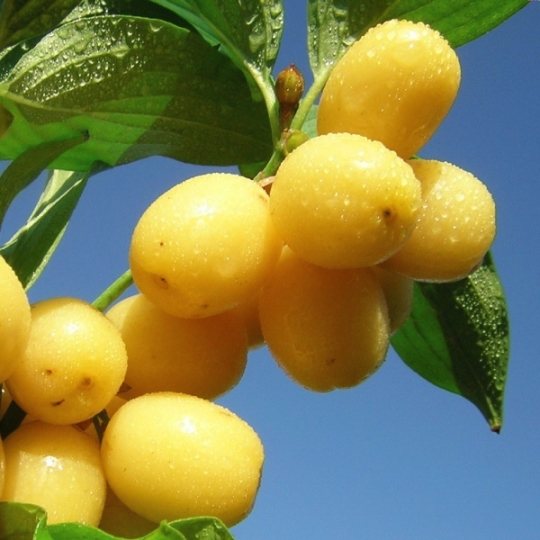

Cornel "Vladimirsky"
Burgundy berries weighing up to 8 g. Ripening time August-September. It ranks first among the representatives of the dogwood in terms of productivity and fruit size. Productivity of an adult bush: from 50 kg.
Dogwood "Firefly"
The berries are large (7-7.5 g), dark red, almost black. Ripening occurs simultaneously, falls on the 2nd half of August-early September. The fruits have a peculiar bottle shape. It can persist after removal for up to a month. Not prone to shedding. The yield of a 20-year-old bush is 60 kg of berries.
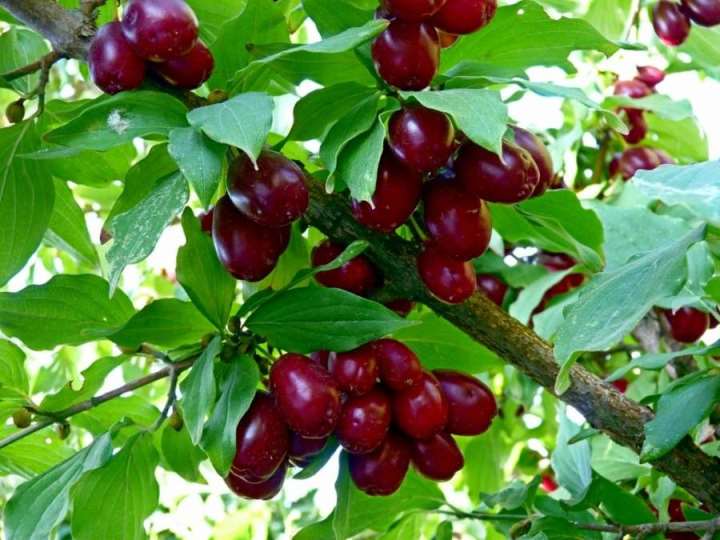

Varieties
There are few dogwood varieties. The register includes:
- Artemy;
- Nastya;
- Pavlusha;
- Prikubansky;
- Samokhvalovsky;
- Solar.
In addition to traditional varieties, gardeners grow interesting novelties.
Amber
Nutritionally valuable yellow-fruited variety, ripens in medium terms. The fruits are transparent to such an extent that the stone is visible - hence the name. The average weight of the berry is 5 g, the shape is short-oval. The taste is sweet and sour, delicate. Yellow-fruited turf contains more sugars and pectins than regular turf. The tree looks elegant, reaches a height of 2 m and forms an oval-pyramidal crown.
Flowering lasts 15 days. The berries do not crumble for a long time, but only gain a dessert taste and delicate aroma. Up to 40 kg of fruits are obtained from the bush.
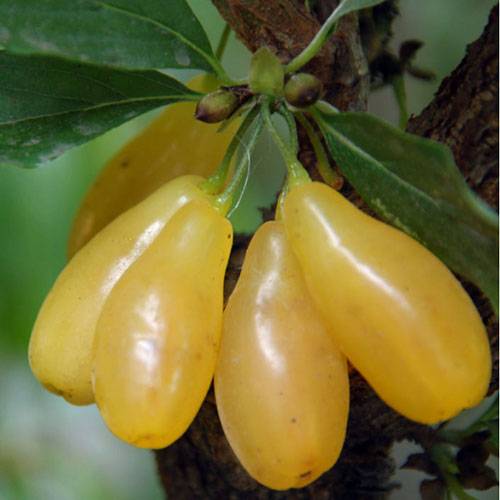

Vladimirsky
It is considered the most productive variety. Large, profusely flowering. Up to 60 kg of berries are harvested from the bush.
Fruits are red, oval, weighing up to 10 g. The flesh is dense, pale colored, the stone is surrounded by a layer of very light tissue. After freezing, the berries become sweeter, but it is not necessary to wait for the snow - a completely edible crop can be harvested at the end of August.
The fruits do not crumble for a long time; when fully ripe, they acquire a pleasant sour-sweet taste. The variety tolerates cold winters well, is suitable for the Moscow region, but in the first years of life it needs to be covered for the winter.
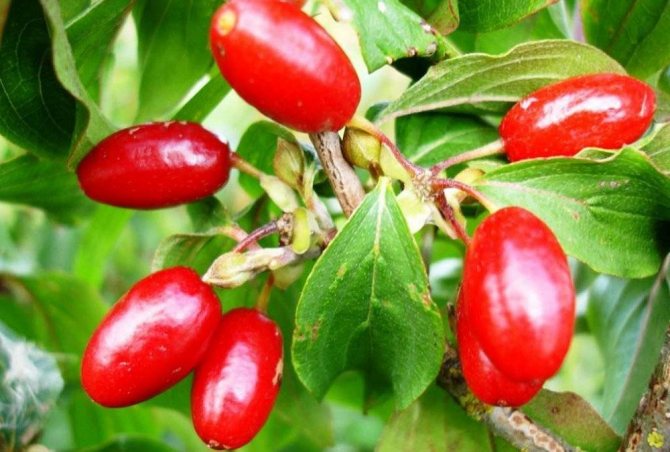

Glowworm
Frost-resistant variety with juicy sweet and sour, slightly astringent in taste, fruits of the color of overripe cherries. The average weight of the berry is about 7 g, the shape is pear-shaped, the aroma is pronounced.
The crop ripens by the beginning of September and hangs for 3-4 weeks without crumbling. Firefly fruits contain up to 17% sugar. Up to 60 kg are harvested from the bush. Plant height up to 2.5 m, oval-pyramidal crown.
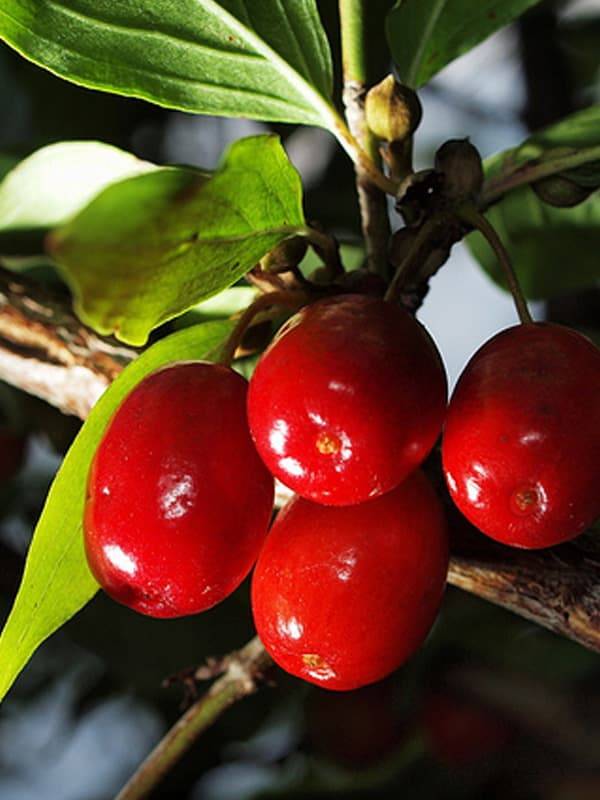

Planting dogwood
Dogwood is grown in various ways: using seeds from ripe berries, layering, grafting, green cuttings, seedlings. A shrub planted with a seedling quickly begins to bear fruit (for 2-3 years).
Optimal planting times
The most favorable for planting seedlings is the autumn season until the second decade of October. The time for disembarkation in different regions will differ, depending on the timing of the onset of frost. Before frost must be at least 20 days. Benefits of autumn planting:
- There will be enough time in the fall for the survival of the shrub, the formation of a developed and stable root system.
- Autumn is a rainy season, it will be easier to organize regular watering of the planted plant.
- In the autumn period there is an opportunity to purchase a fresh seedling, since harvesting is carried out precisely during this period. The quality of the planting material will be better, the cost will be lower. In the spring, seedlings that survived winter storage are sold. There is a risk of buying a dry specimen with rotten roots.
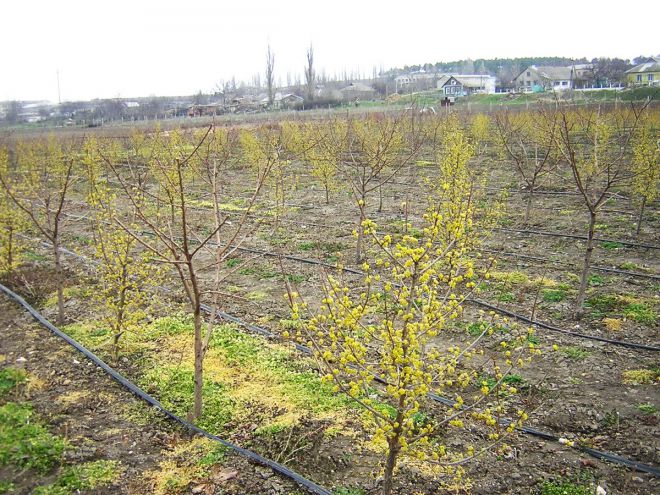

The disadvantage of an autumn planting is that in winter the plant can freeze, break under the pressure of winter winds, and rodents can damage it. In spring, you can also plant in well-warmed soil. The culture is planted in the second decade of February in the southern regions, in early March in the north. Dogwood buds bloom in early spring, and many summer residents do not have time to carry out planting work in a timely manner.
Choosing a landing site
In the natural conditions of the forests of the Caucasus and Transcaucasia, culture grows in shaded places, in thickets of bushes, in illuminated glades. Therefore, for planting shrubs in the southern region, you can choose a partial shade, a free area in the area between the trees. Dogwood does not show special preferences for varieties of shrubs and trees, only the neighborhood of a walnut does not like.
Seedlings up to 5 years old are grown in partial shade, then transplanted to a more illuminated area.
An unpretentious culture will grow and bear fruit on any soil except swampy. The depth of the location of the underground water source must be at least 1.5 meters: the root system of the dogwood is located at a depth of one meter.
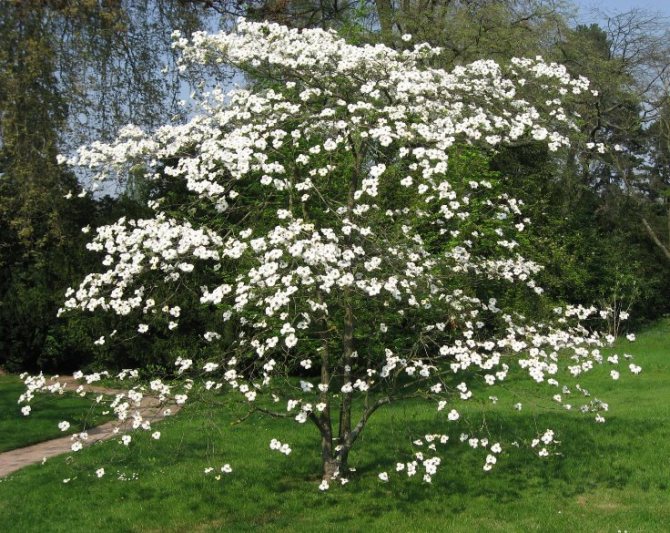

For high-quality and full-fledged fruiting, they create comfortable conditions: they apply fertilizers, regulate the alkaline balance (cornelian cherry prefers alkaline soil), systematically moisten the soil, and carry out drainage measures. How to find out the acidity of the soil? If you put 2 drops of vinegar on a handful of earth, oxidation bubbles will appear in an alkaline environment. With a lack of alkali, the soil is liming (150 g per square meter of land).
In order for the yield of a plant with cross-pollination to be high, it is recommended to place several seedlings of the same ripening period nearby.
How to choose seedlings for planting
Planting material is purchased, as a rule, in specialized nurseries of the buyer's area. The risk of buying a weak, painful seedling in this case is minimal.
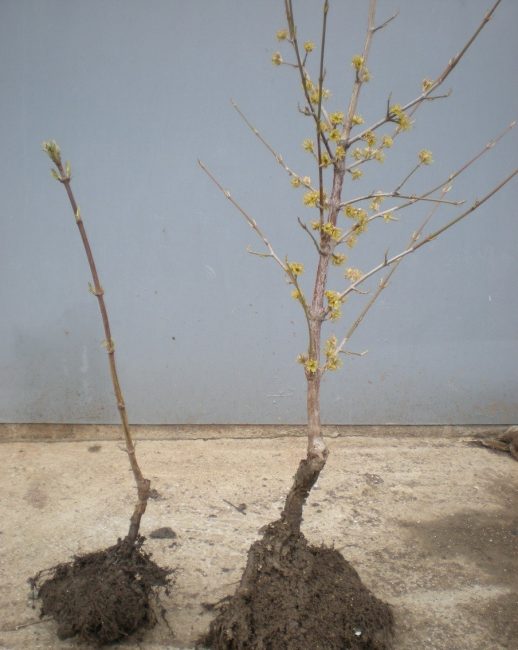

Zoned shrubs are chosen according to the indicators:
- More than 2 years old.
- Plant height from 1 meter, stem thickness 2 cm.
- Roots are strong, branched, healthy, not dry, no signs of decay or disease. There should be 2-3 root branches.
- Skeletal branches 3-5.The bark of the branches is healthy, not damaged.
- A cut under the bark reveals green wood (not brown, an indicator of decay).
During transportation, the roots of the bush are wrapped with a damp cloth and placed in a plastic bag. At the dacha, for safety, a seedling is buried in the ground. Recently, seedlings in containers are increasingly being sold. For planting dogwood, this is ideal. The root system of the plant is closed, the special microflora necessary for the culture will be preserved.
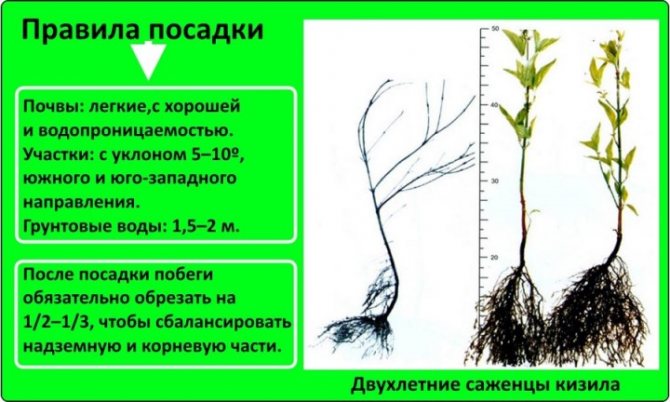

Step-by-step planting process
The land for planting crops is prepared in six months: they dig up, removing weeds, and apply manure, at the rate of 6 kg per square meter. meter of soil. Before planting, the root system is carefully examined, dry, broken branches, leaves are removed (in the autumn season). Cut off shoots by 1/3. The roots of the plant are kept in water for an hour or two, depending on the degree of desiccation of the root system. They are placed in a clay mash and allowed to dry a little. The disembarkation process is carried out in the following order:
- Step 1. A pit for planting 70x70 cm, up to half a meter deep, is prepared in advance, a month before the procedure.
- Step 2. A support for the future shrub is driven into the hole from the windward side.
- Step 3. Introduce the first drainage planting layer 10-15 cm high. It consists of expanded clay, pebbles, broken brick.
- Step 4. In conditions of poor soils, leafy soil is poured onto a third of the pit, forming a mound.
- Step 5. A seedling is placed on the mound, evenly distributing the roots.
- Step 6. Sprinkle the roots with earth, compact it to avoid voids, water it. After the last watering, the root collar will be almost level with the ground. If it is deepened into the ground, the shrub will give a lot of growth. If you raise it too high, the plant will not take root well. When planting, the root collar is 2-3 cm above the ground level.
- Step 7. To preserve moisture, mulch the soil 10-15 cm with dry soil, straw, hay, sawdust, pine needles, leaves.
- Step 8. Experienced gardeners recommend cutting the bush by 1/3 after planting so that 3-4 buds remain on the shoots. If there are not enough kidneys, a cut is made at a height of 2 cm from the highest kidney.
No fertilizers, humus should be added, since the culture is very sensitive to fertilizers.
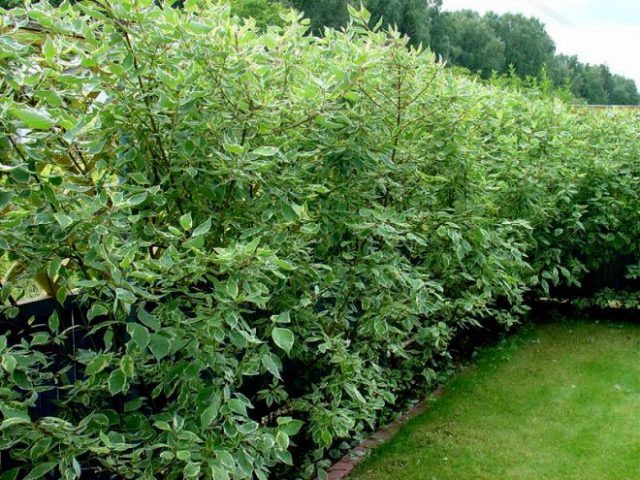

A week after planting, the soil of the periosteal circle is again compacted, the bush is abundantly watered, and mulched again.
What is dogwood?
Cornelian cherry (Córnus mas) is a shrub or short tree from the Cornelian family, common in the wild in the Caucasus. The plant has a second name - male dogwood.
In the gardens, grass is grown up to the Volga region. Despite the heat-loving southern origin of the shrub, enthusiastic summer residents have learned to get dogwood harvests even near St. Petersburg.
The culture is practically not affected by pests and diseases, bears fruit annually, gives maximum yields from the age of ten. 10-30 kg of berries are obtained from young trees, from 30-40 years old to 100 kg.
Translated from the Turkic “kizil” means “red”. The plant got its name because of the very bright color of the fruit, which indicates a high content of anthocyanins. Berries contain a lot of ascorbic acid and pectin substances. This complex allows you to use the dogwood for health purposes. It effectively stimulates digestion, heals the intestinal microflora. Anthocyanin reanimates cells damaged by free radicals. Ascorbic acid is an essential vitamin involved in all biochemical processes in the body.
Cornel is a deciduous tree up to 6 m high or a shrub with four to five trunks up to 4 m long. Its roots are located in the arable soil layer, do not fall below 40 cm, and diverge not in depth, but in breadth, going beyond the crown. The superficial occurrence of the roots makes the culture demanding for watering and nutrition.
Dogwood branches are covered with blackish bark and spread out in all directions. Dark green lanceolate leaves are arranged in pairs. Their length reaches 8 cm. The surface of the leaves is shiny, streaked with long unbranched veins.
Derain blooms with small bright yellow corollas, each of which contains a pistil and stamens. Umbrella inflorescence is collected from several dozen buds. Each consists of 4 petals, 4 stamens and 1 pistil.


The culture blooms early, even before the leaves appear. As soon as the air temperature in spring reaches + 8 ... + 12 degrees, the bush becomes covered with fragrant inflorescences, and becomes a decoration of the site for 2 weeks. Blooming dogwood spreads a pleasant honey smell around itself.
The movement to the north is impeded not so much by the insufficient cold resistance of the dogwood (it tolerates a drop in temperature to -35), but extremely early flowering. Return frosts damage flowers, prevent pollination, which is why the fruits are not set.
Cross-pollinated culture, in order to increase the yield, several varieties need to be planted. Pollen is carried by bees and other insects.
In warm regions, flowering begins in March, in cooler regions - in April. Early flowering explains possible problems with fruiting. At this time, most pollinating insects, and even ants, are still sleeping, and there is no one to carry the pollen. As a result, several berries are randomly tied on the bush, and after a couple of years the frustrated gardener takes up the ax. The pollination situation will be corrected by several hives located nearby.
The fruit of the dogwood is called "juicy drupe" by botany. Ripening takes a long time. The crop can only be harvested at the beginning of September.
Depending on the variety, dogwood fruits can be spherical, pear-shaped, oval. The color is varied - from intense orange to almost black. Bred varieties with white fruits. The average weight of a berry is 5 g. A bone takes about 30% of its weight.
The berries taste sour, juicy, astringent. After the first freezing, they are sweeter.
The fruits can be eaten raw, used for processing and as a seasoning for meat and fish dishes. The high content of phytoncides and astringent tannins allows you to treat intestinal disorders with berries.
Care and feeding of dogwood
Cornel is an unpretentious plant that does not require special care, it will grow even with minimal attention. But to obtain the expected varietal yield, high-quality fruits, regular watering, loosening, weed control, diseases and pests, top dressing, and pruning are performed.
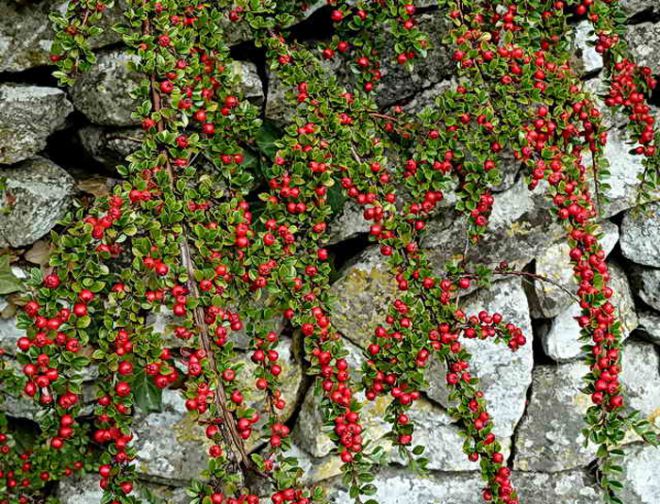

Watering
Regular watering with warm water is the main procedure in the care of the seedling during the first year after planting. Water the plant at least 2 times a week in the near-stem circle, in dry summer - as the soil dries out. Adult plants are watered as needed, avoiding severe drying out of the soil and excessive waterlogging.
Loosening, weeding, mulch
Loosening of the soil to a depth of 10 cm is performed the next day after watering. During the season, at least 6-7 loosening is performed for shrubs of any age. Planted seedlings up to three years of age protect from weeds, weed the soil at a distance of 1 meter from the plant. Mulch the soil after watering and loosening with straw, sawdust, hay, pine needles.
Fight disease
A young bush is prone to infectious diseases. It is treated regularly with fungicides, like all fruit trees. Gradually, with age, the immunity of the bush is strengthened.
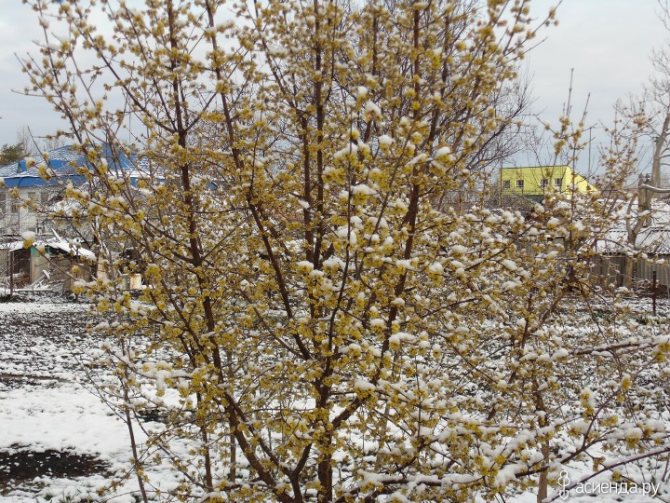

Preparing for winter
Shelter for the winter is produced only for seedlings, since an adult plant can easily tolerate frost over 30 degrees. The soil of the trunk circle is mulched with fallen leaves, branches, 20 cm peat. The shrub is wrapped with agrofibre, burlap. In especially harsh conditions, the plant freezes out, but is restored by shoots.To protect against severe frosts, the bush is spud up as high as possible.
Fertilizer
The crop is fed to increase yields several times during the growing season.
- First time. Every year before the summer season, a solution of chicken manure is added, where 1 part of the manure is added to 9 parts of water. Or fertilizer is applied, which consists of a bucket of humus and 2 tablespoons of ammonium nitrate.
- Second time. During the ripening period, the fruits are fed with an ash solution.
- Third time. After picking the berries, add 100 g of superphosphate.
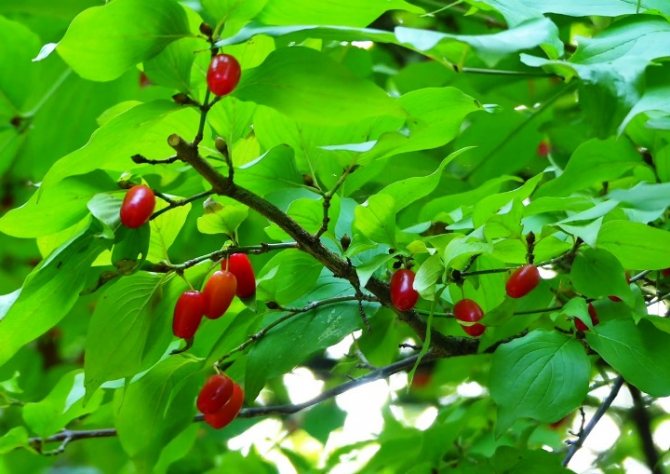

Lime is regularly introduced, which regulates the potassium content in the soil, which is necessary for the development of the shrub.
Experts advise to limit care to a minimum in the first 3 years of shrub development.
How to care for dogwood
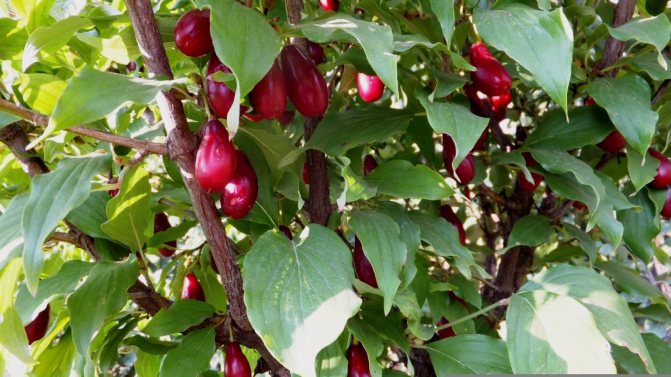

Despite the unpretentiousness of the plant, proper care of the garden dogwood consists in timely watering and feeding, sanitary pruning, removing weeds and systematic tillage.
The culture does not tolerate excess moisture, therefore, when watering, it is necessary to take into account its age, the proximity of groundwater, the level of moisture and soil characteristics. On average, each plant needs at least two buckets of water. Watering can be carried out in the hole made or directly by pouring the holes around the bushes.
After pouring the dogwood, all the furrows need to be smoothed. Water for irrigation is defended by allowing it to warm up. Do not let the soil dry out - this is stress for the plant. To increase the yield, dogwood is fertilized several times a year. It is believed that during the growing season the plant needs nitrogen-phosphorus mixtures, and in the fall - potash.
Some gardeners periodically alternate humus with compost, or annually at the beginning of summer add a mixture of water and chicken droppings under the bushes in a 10: 1 ratio. Others prepare fertilizers from 0.03 kg of ammonium nitrate and a bucket of humus. Also, Agrolife is suitable as a fertilizer, which is sprinkled on the top soil around the fruit crop. At the end of summer, half a liter of wood ash is poured under each adult dogwood.
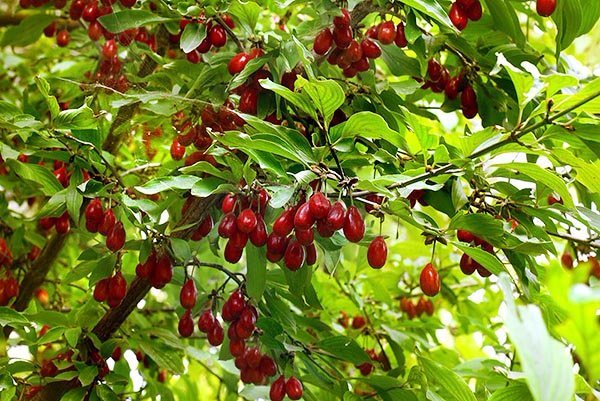

And after harvesting, it would be good to add 0.1 kg of superphosphates. But no matter what you feed the dogwood, lime remains the most important fertilizer. It is she who ensures the presence of potassium in the substrate, which affects the future harvest. With proper maintenance, regular soil treatment is essential. It is done at least six or seven times annually, regardless of the age and fertility of the plant. It starts in the spring and ends in the fall, after harvesting the berries. The culmination of loosening the soil around the dogwood is mulching it.
Important! From a ten-year-old dogwood tree, you can collect up to 25 kg of berries, and from a forty-year-old tree - up to 100 kg.
All the intricacies of pruning dogwood
The culture easily tolerates any kind of pruning. Gardeners perform procedures such as:
- Regular pruning of lower wild shoots.
- Formative crop pruning in the form of a bush or tree.
- Sanitary removal of old, frozen, broken, diseased branches, dry tops.
- Thinning of heavily overgrown, criss-crossing branches.
- Rejuvenating treatments for plants over 15 years old. Produced with a noticeable weakening of the growth of shoots. Perform at the end of winter.
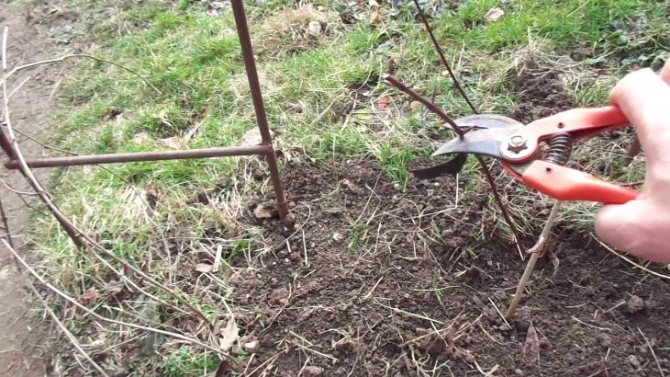

Anti-aging pruning
If the dogwood has already reached a decent age (18-20 years), it is quite possible to rejuvenate it. There are a number of ways to do this.
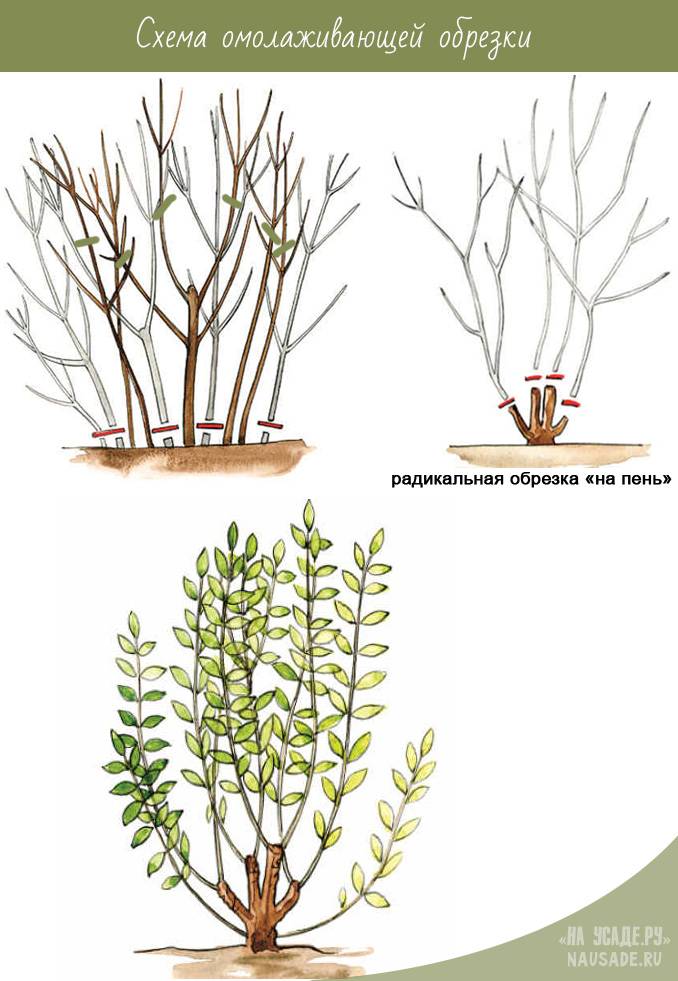

Rejuvenating pruning or how to properly prune dogwood to improve fruiting:
- One-third shortening of all shoots and complete pruning of all old branches. It is necessary to prune after the gardener has examined the plant and attached information flags (where the shortening will be done, and where the branch will be completely removed).
- Plucking off flower buds at the ends of relatively young shoots and completely removing old ones.
Transplanting a shrub to a new location
In the process of transplanting dogwood, the method of "dividing the bush" is used, which is used for reproduction of crops. The plant is transplanted in early spring before the buds swell or in autumn after the end of the growing season. The bush is dug out of the ground, the roots are cleaned. Old, sick, broken branches are removed. Divide the bush into several parts. Each part should have developed roots and several branches. The roots are slightly shortened, non-viable processes are removed. Parts are planted in prepared planting pits.
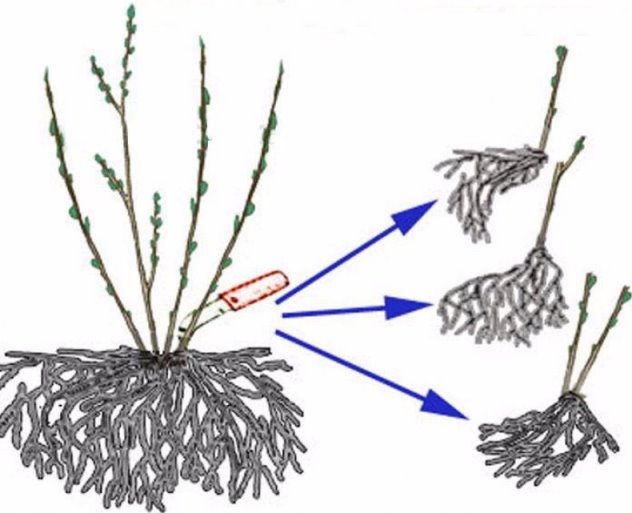

How to propagate dogwood by vaccination
Grafting, or budding dogwood, is the most preferred way to propagate the plant. It can be carried out both in the spring, during the period of sap movement, and in the second half of summer, when the bark on the rootstock lags more easily.
Grafting is carried out on two-year-old wild dogwood seedlings at a height of 10-15 cm, and for standard forms - 75-80 cm. The stock is cut horizontally with a sharp pruner, and a deepening is made in the middle of the cut. The scion is prepared as follows: the upper oblique cut is made directly above the bud and processed with garden pitch, the lower one is cut with a wedge - two cuts with an edge of 4 cm.The total length of the scion cutting should be about 15 cm as a result. so that part of the cut remains outside. The grafting is wrapped in a transparent film, after which the bush is sprinkled with peat mixed with sand to the grafting site.
A grafted plant placed in a greenhouse takes root faster (the scion and rootstock grow together the faster, the higher the ambient temperature). After accretion (this will be visible through the film - the open place of the scion will be covered with callus), the film can be removed, transplanted into the open ground and subsequently cut off all the shoots that will grow from the rootstock.
Harvesting and storage
Dogwood fruits ripen gradually. You can determine the degree of ripeness of the berries by tasting the berries. Ripe fruits have a pleasant sweetish taste with sourness, a dense structure. Overripe berries are soft, not suitable for transportation and storage. Slightly unripe fruits are harvested by hand and placed in containers. The collected berries are kept in small containers for 2-3 days for full ripening and sent for storage. Fresh berries can be refrigerated for up to 12 days. They are placed in plastic bags. Temperature range 0- + 2 degrees.
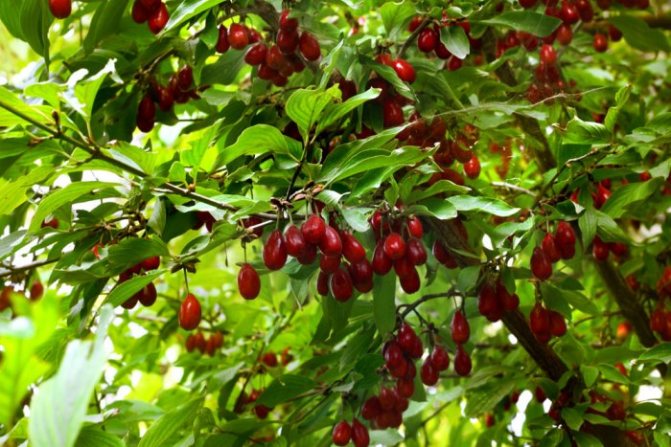

The vitamin composition of the product is well preserved when stored in the freezer of the refrigerator. Fresh berries, covered with sugar in a ratio of 1: 2, retain their beneficial properties. The product is stored in the refrigerator. Jam, jams, juice, compote are prepared from dogwood. In addition to berries, they use bark, leaves, cornel roots for the preparation of decoctions, tea, and tinctures. The bark is harvested in early spring, the leaves - during the flowering of the plant, the roots - in late autumn. For storage, they are dried and placed in paper bags.
Cornel is a shrub that, when fruiting, produces delicious sweet and sour fruits rich in vitamins and minerals. Berries are beneficial for diabetics, as they quickly lower blood sugar levels. Dogwood planting and caring for which even novice gardeners can do it requires adherence to some rules. Knowing them, you can get rich yields of dogwood, from which infusions, compotes, and conservation are prepared.
Dogwood propagation by layering
Vegetative propagation of dogwood is perhaps the easiest way to get a new plant. Layers can be made horizontal and arcuate. In autumn or very early spring, one-year-old shoots or two-year-old branches are chosen on a young bush, bend to the ground (first, the earth in these places must be well dug up and mixed with fertilizing), wooden studs are fixed, sprinkled with earth on top (the tops of the layers must be pinned, lifted and tied to vertical support) and watered regularly.After the emergence of shoots from the buds of the sprinkled layer, they need to be sprinkled twice, with an interval of two to three weeks, with fertile soil. Next year (preferably in spring), young plants are separated from the bush and transplanted immediately to a permanent place.
General information about the plant
Dogwood grows in mid-latitudes. Forms a powerful bush. Fruits from 2 to 5 cm in length, deep red color. I fell in love with this berry for such useful properties:
- The high content of vitamin C (more than lemon) boosts immunity.
- The diuretic and choleretic effect helps fight cholecystitis, cystitis and bacterial diseases of the genitourinary system.
- Used in the treatment of gout. The pronounced diuretic effect prevents the development of edema.
- Cornel tinctures are used in the treatment of skin diseases.
- Compote helps to satisfy hunger, which leads to the normalization of metabolic processes and promotes weight loss.
The fruits are well stored in dried and frozen form, without losing their medicinal properties.
When the shoot comes into contact with the soil surface, a root system is formed very quickly. This principle is used to propagate shrubs.
Dogwood can be formed by a bush, carrying out annual pruning, or it can be grown as a tree. The stem is formed on the strongest base, not allowing lateral shoots to take root.
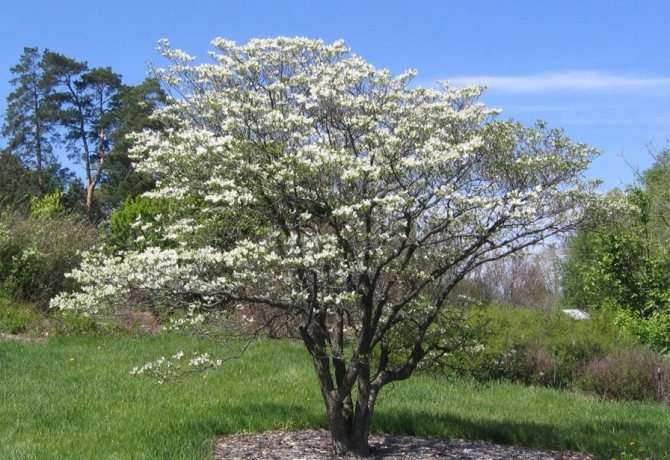

Dogwood in bloom
The plant tolerates winter well enough. In those regions where the temperature drops below 30 ° C, there is a need for additional insulation of the root zone with the help of fallen leaves.
The main feature of the dogwood bush is the fact that it bears fruit every year. So that the harvests are plentiful without abundant watering, weeding and dressing cannot be done.
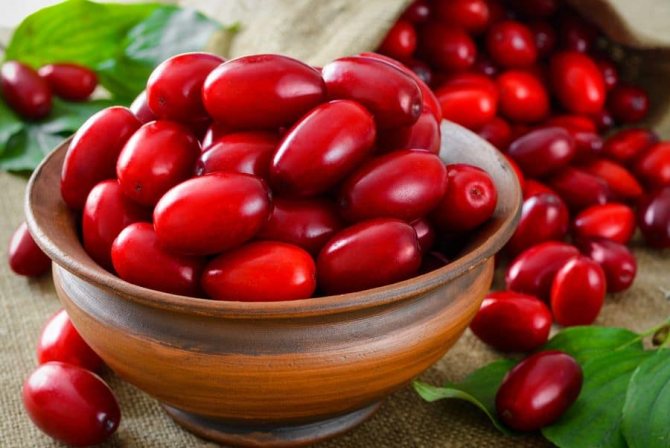

Dogwood berries
Dogwood propagation by root suckers
There is also such a way of breeding dogwood, as planting root suckers. For this, shoots are used that grow around a healthy adult bush. It is simply separated and planted separately. This can be done both in spring and autumn. However, it must be borne in mind that if the plant was grafted, then this method is not used, since the shoots are part of the stock - a wild species of dogwood.
When using any of the methods described above, the main problem is how to plant the dogwood so that the plant takes root. If the technology is followed at this point, in the future the shrub does not cause any particular problems in care.
Selection criteria for seedlings
To get good yields of dogwood, you should plant several seedlings at once. The best option would be 3-4 seedlings, planted at a distance of no more than 3.5 m between each other. Planting material requirements:
- Age - for good rooting, seedlings that are already 2 years old are used. Young seedlings hibernate poorly and there are risks of being left without dogwood at all. Overgrown saplings, which are more than 3 years old, also do not take root well in a new place, since when digging up the abundantly developed root system is injured.
- Dimensions - the height of the seedling should not be less than 1.5 m, and the thickness of the trunk should not be less than 2 cm. Weak and flimsy stems are a sign of various diseases and an acute lack of nutrients.
- The presence of lateral shoots - on the main trunk there should be at least 5-6 lateral pagons, which is a sign of active growth of the shrub.
- Root - The root system should be well developed, and the small roots should be free of visible signs of damage. If we consider the roots, then they should be soft and elastic, insects and their larvae should not meet between them.
- Absence of external signs of diseases - the bark on the trunk should be of a uniform color without grooves, holes and damage.
Dogwood cuttings
Reproduction of dogwood by green cuttings should be carried out in the summer and only when the growth of young shoots stops.
Cuttings must be taken from an adult (at least 5 years old) healthy shrub. From any branch in the morning, a top 10-15 cm long is cut off, from which all leaves are removed with a pruner, except for two or three upper ones, and an oblique cut is made at the end of the shoot 5-10 mm below the bud. The stalk prepared in this way is placed in a growth stimulator for several hours, washed with cold water and planted in a greenhouse prepared in advance; the loosened soil is covered with a thick (up to 10 cm) layer of coarse sand, previously sifted and washed.
Cuttings are planted very densely, at a distance of 3-4 cm from each other. The distance to the top of the greenhouse from the top of the cutting should be 15-20 cm. Then the cuttings are watered and covered with foil.
The air in the greenhouse should be humid and warm enough, but not higher than 25 ° C, if necessary, the greenhouse should be ventilated. Cuttings also need constant watering. The root system of cuttings, with proper care, is formed in one and a half to two months (depending on whether they were previously subjected to a growth stimulation procedure). At this time, you can begin to temper the cuttings: the film is first removed from the greenhouse for a short time, gradually increasing it so that by the tenth day the film is completely removed.
In the future, the sprouted cuttings are transplanted into a nursery, allowed to take root, and then fed with nitrogen fertilizers or organic matter (manure). The next year (in spring or autumn), the seedlings can be transplanted in a place designated for an adult bush.
The method of propagation of dogwood by cuttings is not very popular due to its low growth rate.
Principles of growing dogwood
In order for the shrub to be comfortable and to please with a bountiful harvest, it is important to choose the right planting site, decide on seedlings, as well as watering and fertilizers.
Seat selection
Dogwood feels great both in open space and near a fence. The preference is given to the south side. So the shrub will receive the maximum amount of sunlight, which is extremely necessary for the formation of the crown and the laying of the first berries.
The preferred soil for dogwood is loam and black soil. It is encouraged to fertilize the soil with peat, humus, phosphate fertilizers and wood ash before planting.
To obtain the maximum effect from planting, as well as cherries, dogwood is planted in pairs. This principle is used to increase cross-pollination. It is recommended to plant seedlings at a distance of 5-10 m from each other.
Cornel forms a crown, so you should think about its location in advance: whether it will give a shade to vegetable crops and whether it will "hammer" other plantings.
Landing dates
Plant dogwood in the same way as grapes. Two-year seedlings take root better if they are planted in open ground in September-October. During this period, it is not so hot, there is no drought. It is possible to build up the root system and prepare for the first wintering, which requires covering the root zone with a thick layer of leaves or cut grass.
Some gardeners practice planting seedlings in early spring, justifying this by the fact that the first harvest can be obtained by August. However, in practice, this does not always work, since a young shrub first forms a crown, and only after that gives fruit.
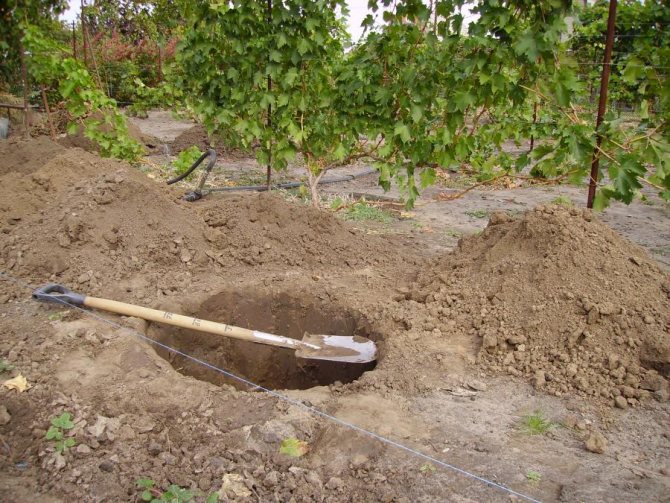

Pit for planting dogwood seedlings
Planting scheme and stages
After the necessary seedlings are selected, planting is carried out according to the scheme:
- Soil preparation - with the help of a shovel, they make a depression in the ground with a diameter of 60 and a depth of 100 cm, where 1 part of peat, 2 parts of humus and 1 part of wood ash are placed. A pit of 20-30 liters of water is well spilled, which is allowed to go well into the ground. This is necessary in order for the forming root system to grow downward.
- Support preparation - use a wooden stake, which is driven directly into the hole.It will serve as a support for the young shrub and will not allow it to lie on the ground until the crown has formed.
- Seedling preparation - each seedling is inspected for damage. The root system is placed in a weak manganese solution for 15 minutes, then in salt water for 20 minutes.
- Planting in a hole - gently straighten the root system of the seedling and sprinkle it with a previously prepared soil mixture so that the neck from where the main trunk leaves always remains on the surface. This will help to form the future crown correctly.
- Formation of the root zone - so that the shrub does not suffer from drought, the root zone is formed in the form of a groove. When watering, all the water will go into the roots and will not spread.
- Mulching - used to prevent moisture evaporation, as well as to preserve the roots during frost. Fallen leaves of maple and poplar, mown grass, straw are well suited for mulching.
- The first pruning - after the seedling is planted, it is shortened by 1/3. This is necessary in order for the plant to use all the forces on the formation of roots, and not on the production of green mass. Pruning is done with a pruning shears or pruning shears pre-treated with an antiseptic. The cut is treated with brilliant green and sprinkled with wood ash.
- Garter - after pruning, the seedling is tied to a stake so that during the period of watering and hilling it does not accidentally fall and damage the ground part.
Preparing dogwood for pruning
The plant that is being prepared for pruning should not have open infected foci. This condition is due to the fact that when damaged, it can spread throughout the plant, like any infected wound. In addition, it must be free of weeds in the near-trunk circle, and not suffer from drought or over-watering.
Therefore, before pruning, it is necessary to carry out a number of the following actions (when planning spring pruning, all these activities are carried out in the fall).
- Weed the plant (remove all weeds in the trunk circle).
- Slightly loosen the soil around the plant (to a depth of no more than 10 cm).
- Mulch the trunk circle with peat or any organic materials.
- Carry out treatment for diseases and pests (if pruning is carried out in the fall, then all preventive and therapeutic treatments are carried out in August-September, if in spring - then in autumn and early spring, even if the snow has not melted yet).
The nuances of plant care
To get a good harvest of an acidic, but very healthy berry, you need to take into account the following nuances:
- Watering - carried out every 10-12 days. Pour 20-30 liters of water at a time into the root zone.
- Top dressing - in the period before frost, the plant is poured with potash and phosphorus fertilizers. In early spring, organic fertilizing will be required, which will stimulate the growth of green mass. During flowering and fruiting, the shrub needs calcium, potassium and phosphorus fertilizers. If the dogwood has not wintered well and there are clear traces of frostbite, you can use growth stimulants that will help strengthen the young seedling.
- Pruning - Spring pruning is done in late February - early March, when the shrub is still dormant. All damaged and dry branches are removed, as well as those pagons that go deep into the bush. All cut sites must be treated with an antiseptic.
- Spring treatment against pests - dogwood tolerates wintering well enough and is practically not susceptible to diseases like apple or sweet cherry. To prevent rust and fungal diseases, prophylactic treatment with Bordeaux liquid is recommended.
- Reproduction - reproduction by rooting the lower branches that slope towards the ground is considered the best option. In September, such branches are bent to the ground, pressing down with something heavy and covering with mulch.
For culture rejuvenation, bone reproduction is used.The ripe berry is cleaned of pulp and placed in a container with moist soil mixture. After germination of the sprout, it is gradually dived into a container with a large volume, not forgetting about the introduction of mineral and organic fertilizers.
Cornel is perfectly stored in freeze and dried form. Delicious compotes, jams and preserves are made from its fruits. Fresh berries are rarely consumed, since they are quite sour and sometimes tart.
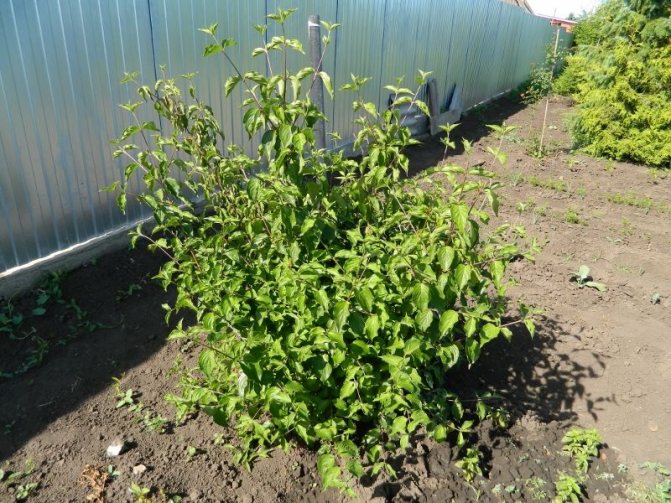

Growing dogwood in a personal plot
Preparing dogwood for wintering
Gardeners of the northern regions know that dogwood is winter-hardy enough, can withstand quite strong drops in temperature (even down to -30 -35 ° C), if they are not long-term.
Even winter frosts are more dangerous for a southern guest, and thaw in the middle of winter and severe frosts in the spring. Because of the thaws, the dogwood, which begins its new cycle out of time, then does not have time to return to a state of dormancy, and flower buds suffer from recurrent frosts.
A peculiarity of the genus is that the already blossoming flowers are able to close again, as if returning to the state of a bud. Such metamorphoses are not beneficial for pollination and, as a result, reduce yields.
But, despite all these difficulties, gardeners are successfully growing dogwood in the Moscow region and even to the north. The following agrotechnical methods help to preserve young plants (they still have a fragile root system and a vulnerable stem) in the early years:
- After the dogwood sheds its leaves (in the autumn leaf fall), it is necessary to shake off the old mulching material and remove the foliage.
- From above, on the surface of the trunk circle (up to the trunk), lay a layer of humus, sprinkle it with a "slide" on the trunk, covering it by 20-40 cm.
- Wrap the whole plant (young) with non-woven agrofibre (at least 40 thick) and tie the shelter so that it is not blown up by the wind. It is convenient to cover taller plants with burlap.
- After the first snowfalls, form snow mounds (drifts) around young plants. Snow powder will not damage older bushes.
HOW AND WHEN TO PLANT CORNELS?
For planting dogwood, the soil is prepared in advance, in summer or autumn. It is best to plant it in early spring, in late March - early April, before bud break. However, under favorable weather conditions, you can plant dogwood in the fall, but no later than mid-October, 2-3 weeks before the onset of frost. Well-watered and sprinkled plants have time to take root, winter well, and in early spring they immediately start growing. To improve the growth and fruiting of dogwood, organic fertilizers are applied before planting. Planting holes are dug with a diameter of 80-100 cm and a depth of 70-80 cm. Then they are filled with good fertile soil, mixed with organic and mineral fertilizers. Humus and compost are divided into two parts, one part is mixed with the top layer of soil and mineral fertilizers and the hole is filled up to half in the form of a mound. The second part is poured directly into the roots when planting. The planted plant is watered at the rate of 30-40 liters of oxen per hole, the trunk circles are mulched. After planting, the shoots must be cut by 1 / 2-1 / 3 in order to balance the aboveground and root parts.
How to grow a dogwood from a bone
The seed propagation technology of dogwood is rather lengthy and laborious. It begins in the fall, after harvesting the fruits. To begin with, the bone should be carefully peeled from the pulp. Then it is placed in a humid environment (for example, in sawdust or moss), where it stays for a whole year. All this time it is necessary to ensure that the moss does not dry out. Thus, an imitation of the natural conditions in which the seed hibernates takes place, which is necessary to increase the reliability and speed of its subsequent germination (the so-called stratification). You can plant the seed directly into the ground, in this case it will rise in the second year (you won't be able to save time), but the germination rate will be much worse.
The prepared bone is immersed in the ground to a depth of about 3 cm. After the first shoots of dogwood appear, they must be protected from direct sunlight, watered and fed as needed. In the fall of the second year after planting (the sprouts by this moment grow to 10-15 cm), the dogwood is ready for planting in open ground, but the bush will give its first fruits only after a few years (from seven to ten). Thus, a lot of time is required for the reproduction of dogwood from the bone: 14 years can pass from the beginning of preparing the seed to harvesting.
For reproduction of dogwood from the bone, wild types of shrubs are used, after which a selection dogwood is grafted onto the grown seedlings.
FEATURES OF CARING FOR KIZIL IN A GARDEN AREA
Plant care consists of removing weeds, loosening the soil, feeding and watering. Dogwood grows very well in slight shade, especially in the first years after planting. It is advisable to fertilize the trunks of young trees in autumn or spring with organic matter at the rate of 2-3 kg / m2. Mineral fertilizers are applied as follows: phosphorus (30-35 g / m2) - in the fall, nitrogen (15-20 g / m2) and potash (10-12 r / m2) - in the spring. Annual grafted dogwood seedlings must be mulched with sawdust, peat, humus or cut grass.
RARE PLANT SEEDS FOR YOUR GARDEN - FREE SHIPPING. PRICES ARE VERY LOW. THERE ARE REVIEWS


Decorative trim
If the goal of the gardener is not so much the cultivation of a fruitful crop, but the decorative design of the garden, the creation of a hedge, then the dogwood can be pruned in order to form exotic crown shapes.
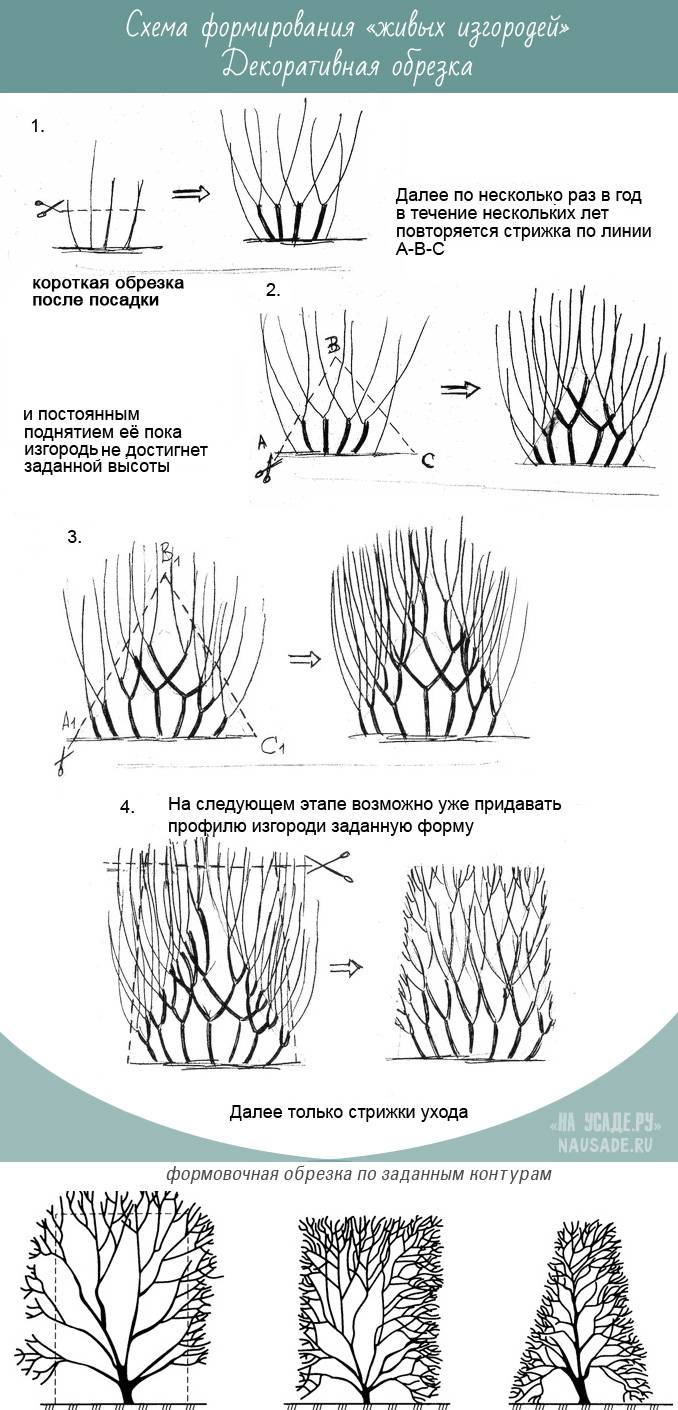

With skillful formation, it is possible to get beautiful, elongated-tall specimens and fluffy, spreading bushes and balls, and even weeping tree-like plants. After decorative pruning, dogwood care is standard - feeding, watering, mulching the soil. Decorative pruning and tree rejuvenation can be carried out in parallel.
CORNER CUTTING
Cornel does not require special pruning for fruiting, however, the formation of the crown must be done in the first years. Saplings are formed with a stem 50-70 cm high and 5-7 skeletal branches. At the same time, shoots located below the planned height of the trunk are removed. In the future, pruning of fruiting plants is reduced to the removal of broken, intertwining skeletal branches and small shoots that thicken the crown. February or earlier), before sap flow begins.
How to prune dogwood in the fall
If the gardener nevertheless decided to carry out sanitary pruning in the fall, then after carrying out the above steps, it is necessary to especially carefully prepare the dogwood for wintering. How to do this will be discussed a little later.
Formative pruning
Pruning and shaping in the first or second year of the plant's life (or it is also called primary) is carried out in order to form the crown of the dogwood in the form of a "bowl". This form significantly increases the number of fruiting shoots, stimulates the plant to bloom and gives it a beautiful shape.
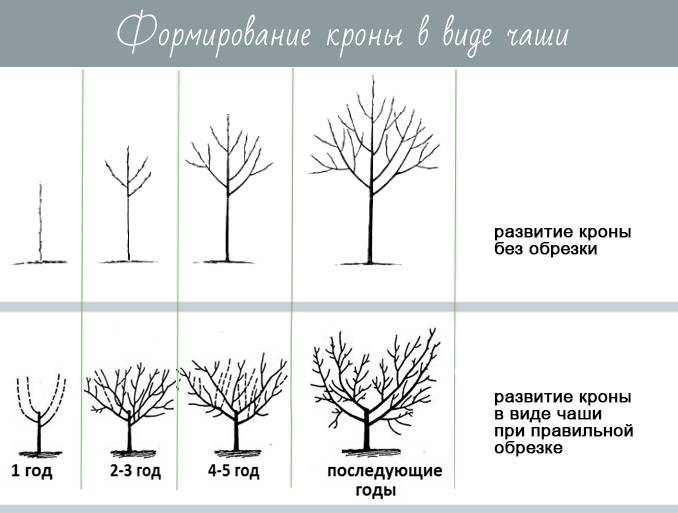

The order of formation and the scheme of correct pruning of dogwood:
- With a sharp, disinfected pruner, cut off the main stem - the guide to the first fork of the bearing branches. Since the dogwood branches are arranged in pairs, it is very easy to select the desired pair, which will begin to form a "bowl". You also need to leave one more branch from the next pair. The standard “bowl” of a first year formed dogwood consists of three skeletal branches.
- Further pruning consists in removing all shoots that go straight up. Convert the “vertical” of dogwood growth to “horizontal”, forming a shallow crown, in which the shoots will have a slope of at least 30º degrees - the main task of the formative pruning (sincebranches that branch off at a very sharp angle (less than 30 °) usually compete with the trunk and begin to thicken the crown).
- During the rest of the growing season, a supporting pruning is carried out - they cut off the "extra" shoots that thicken the crown and branches that go below the grafting - from the wild, otherwise they can drown out the growth of cultivated ones and sooner or later destroy the variety.
This video describes in detail how to prune dogwood in the spring (to carry out a formative pruning "bowl") in the first year. Watching the video will be especially useful for beginners.
It is necessary to care for the dogwood after pruning carefully, and, especially, to monitor the absence of infection and pests. Feed the dogwood in the fall to strengthen it is useful with potash fertilizer, ash works very well.
HOW TO SPREED DOGS IN THE DACHA?
An effective way to propagate dogwood is by layering. It consists in stimulating root formation on the stem before it is separated from the mother plant. The number of cuttings obtained from one plant depends on its age and habit. From one tree, 5-8 cuttings can be obtained annually.
REPRODUCTION BY PUBLICATION "IN APPLICATION"
This method is the most effective, since the ocular survival rate is 90%. The usual time for budding is from July 25 to the end of August. The technique is the same as for other fruit plants - with an eye behind the bark in a T-shaped cut or "butt", it all depends on the weather conditions. Budding is done without taking into account the state of the bark on the stock. This method makes it possible, if necessary, to extend the budding period until the end of August, and even until September. As a rootstock, two-year-old dogwood seedlings from seeds of cultivated varieties or wild are used. The seedlings begin to bear fruit in the 2-3rd year, while the seedlings - only in the 5-7th year. 1 CUT OFF THE BARK ON THE ROOT At an angle of 45 °, make an incision in the bark 5-6 cm long. Cut a strip of bark 2-2.5 cm long, remove the shield. 2 PREPARING THE SHIELD A shield with a bud is cut from the cuttings of the scion, its length should correspond to the length of the tongue on the rootstock. 3 INSERT THE SHIELD The shield is inserted by the tongue of the bark "in the butt". If the tip of the flap extends beyond the cut, it is shortened. 4 TIRING THE SHIELD The site of inoculation is tightly tied with foil, washcloth, paper twine or insulating tape.
Reproduction
The easiest way is to breed the turf by layering. The specimens obtained in this way begin to bear fruit in the third year.
Operating procedure:
- bend branches growing low;
- secure with metal pins or heavy loads;
- sprinkle with earth so that the top is outside;
- water regularly.
Cuttings can be dug out next fall.
Reproduction of dogwood by green cuttings is difficult and is used only in industrial conditions. Valuable varieties can be propagated by budding, which is carried out in the middle of summer. Vaccination is done on wild dogwood.
If the cultivation of dogwood in the form of purchased seedlings fails, seed breeding is recommended. Seedlings are adapted to atypical conditions, better tolerate cold and a short growing season, but do not retain the taste characteristics of the mother plant.
Dogwood seeds require long-term stratification; they emerge only in the second or third year after sowing. Seedlings can be used as a stock.
Seedlings begin to bear fruit only in the sixth year. To make the berries appear faster, in the second half of summer, the plants stop feeding and watering. After that, the shrub slows down vegetative growth, and starts flowering the next year.
WHAT CONDITIONS DO KIZIL NEED?
It is advisable to plant dogwood on soils of light texture, with good air and water permeability. Well-warmed and illuminated areas are suitable for this culture, with a slope of 5-10 °, south and south-west. The groundwater level should be no closer than 1.5-2 m.Calcium must be present in the soil to stimulate plant growth and development, as well as other nutrients. For good pollination of plants, it is better to plant several different varieties, since they bloom at the same time.
So: With good lighting and moisture, seedlings develop powerful roots. For better pollination, several trees are planted on the site, or another variety is grafted into the crown of the plant. Dogwood can be propagated by rooting green cuttings.
Dogwood species
There are many varieties of this crop, but the following are the most popular:
- "Present". This is a European species called turf. The description of the dogwood variety indicates that it is characterized by fruits of a deep red color, which have an original smell and a sweet and sour taste. He lives for 150-200 years.
- "Flowering". This variety is distinguished by its decorative effect, therefore it is widely used in landscaping. The distinctive parameters include high winter hardiness.
- "Drug". It grows in Japan, Korea and China. It is used as a remedy. This variety is characterized by drought resistance and winter hardiness. The bark of such a dogwood is brown or orange, planting and caring for this species has some features,.
- "Swedish". It is a herbaceous plant that has creeping stems with underground rhizoids. It grows in areas with high humidity.
- "Canadian". The shrub is dense and with small inflorescences. Fruits of red color are collected in compound fruits. This variety tolerates shading well.
- Nutalla. This species is considered mountainous. It is characterized by a multi-flowered inflorescence and an ellipse-shaped fruit. Growing can be practiced even in greenhouses, for example, in tubs made of wood.
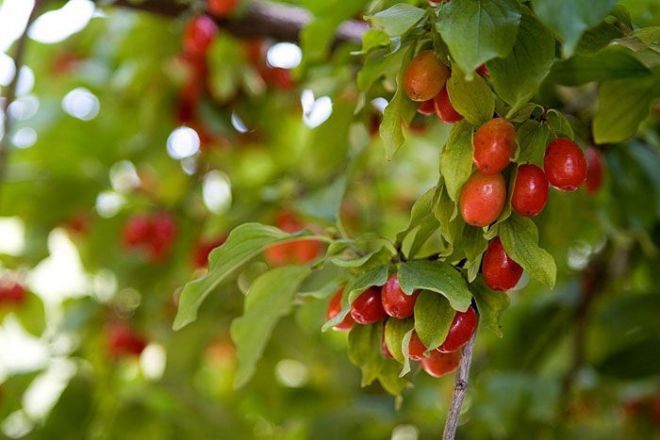

Popular ones that have not lost the useful properties and qualities of dogwood that are suitable for growing in the country
1 VLADIMIRSKY Large-fruited and fruitful variety. The fruits are one-dimensional. weigh 7.5 g. Fruit attachment strength is good. 2 VYDUBETSKY Fruits are large, weighing from 6.5 to 7.6 g. The strength of fruit attachment is good. 3 CORAL BRAND Fruits are pink-orange, round, barrel-shaped, similar to cherry-plum fruits, average weight - 5.8-6 g. 4 LUKYANOVSKY Fruits are large, bottle-shaped, dark red, sometimes almost black. Average weight - 6 g. 5 GENTLE Annual fruiting, stable. Fruits are yellow, bottle-shaped. 6 Glowworm One of the largest-fruited varieties. Fruits are large, bottle-shaped, with a thickened neck, weigh 6.5-7.5 g. 7 SEEDS Fruits are large, broadly pear-shaped. on average weigh 6-6.5 g. in ripe cherry-dark. 8 EXOTIC Fruits are large, cylindrical, black-red, weighing 6.8-7.3 g. They hold well on the tree after full ripening. 9 ELEGANT Bottle-shaped fruits with a thin neck, uniform in shape and size, weighing 4.5-5 g, cherry-black when ripe. 10 VAVILOVETS Fruits are large, weigh from 6 to 7.5 g, pear-shaped, red-black. 11 GRENADER Fruits are large, with an average weight of 5-5.3 g. Fruiting is annual, stable. 12 EUGENIA The variety ripens at the same time, does not crumble. Fruits are dark red, large, regular oval. 13 ELENA Winter-hardy variety, crumbling. Fruits are one-dimensional, weigh 5 g, dark red when fully ripe. 14 NIKOLKA Fruits are dark red, almost black, ripen simultaneously, one-dimensional, with an average weight of 5.5-5.8 g. 15 PRIORSKY Winter-hardy variety. Fruiting is annual, uniform, abundant.
22
Dogwood pests and diseases
Damage to dogwood by sucking and gnawing insects is sporadic, because there are no large-scale plantations in our area. The dogwood butterfly does not bypass its attention, whose caterpillars "chew" the leaves. In the leaves themselves, the caterpillars of the pointed-winged moth can live. They are so small that they are invisible to the naked eye, and they live inside the leaf.Their presence is indicated by light stripes on the leaves. Micro-moth butterflies lay eggs during the period of flower formation, and hatched caterpillars in summer are mistaken for juicy berries. To get rid of caterpillars will help spraying with insecticides Aktara, Akarin, Fitoverm in accordance with the instructions or a harmless biological product Dendrobacillin (0.5 g per 1 m2).
Photo gallery: dogwood pests
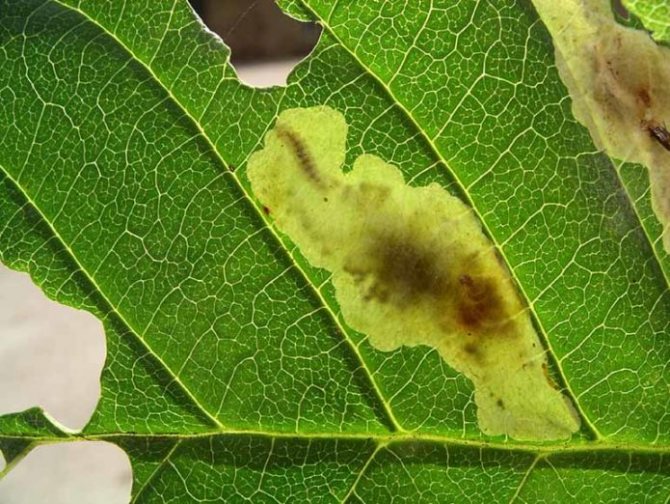

A pointed-winged moth caterpillar settles inside a leaf
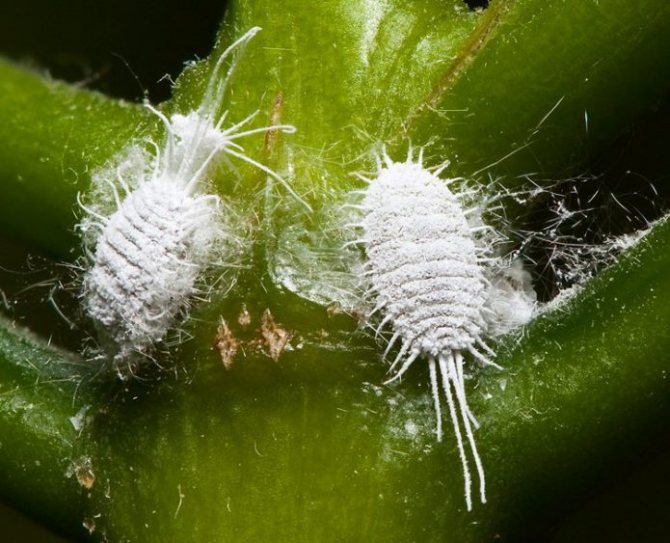

Small worm can do a lot of damage
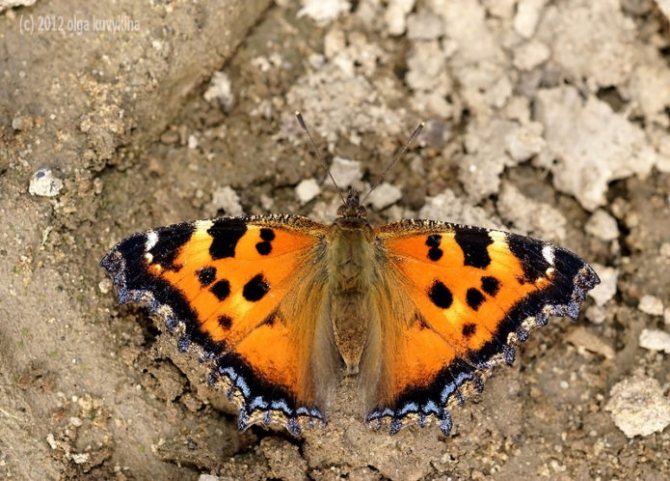

Caterpillars of the polychrome butterfly eat the leaves
Snail worms, whitish wingless insects, live in Septobasidium - mushrooms-epiphytes, similar to lichens, on dogwood branches. But, if the mushroom uses the dogwood as a support, then the worms, crawling out of it, suck the juices from the young twigs. Because of this, the shoots are bent, the ovary falls off. Spraying with lime is carried out against the worm (1-2 kg per 1 bucket of water). Lime will additionally protect the plant from overheating and sunburn.
When spraying plants with a lime solution, small holes of a conventional sprayer are clogged with lumps of lime, and therefore it is better not to use it. It is more convenient to make a special baffle plate for the sprayer - a plank. Striking the flap, the jet will take a fan-shaped shape, and the calcareous liquid will lie in an even layer on the plant. When working with quicklime, use glasses.
Voropaev M.S.
Traditional diseases of dogwood include:
- powdery mildew - white bloom on all parts of the plant, mostly young bushes are sick;
- rust (usually appears in the middle of summer) - leaves become covered with yellowish and rusty spots that interfere with the process of photosynthesis, lead to the death of leaves and worsen growth;
- necrosis - the causative fungus, multiplying on dead branches, affects weakened and damaged shoots.
Photo gallery: signs of dogwood diseases
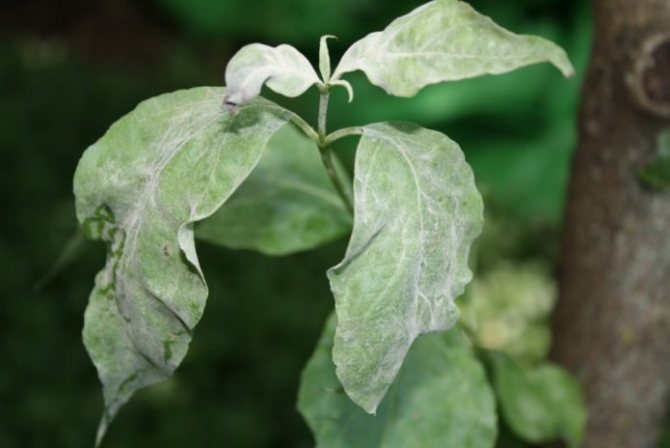

Regular inspection will detect powdery mildew at an early stage
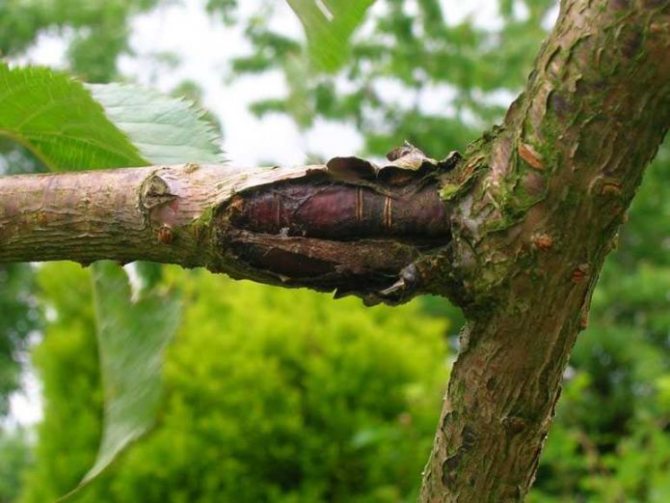

Tree necrosis is treated with amputation
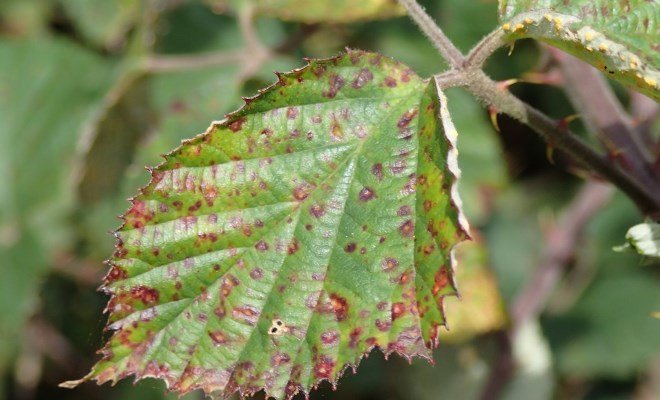

The age of the rusty leaf is short
In the fight against powdery mildew and rust, spraying with a 1% solution of Bordeaux liquid with an interval of 15–20 days will help (the last treatment is 20 days before harvest). The affected parts of the plant are removed and burned. Another option for spraying against rust is rotted cow dung:
- Pour manure with water in a ratio of 1: 5.
- Insist in a closed container for 1.5–2 weeks, stirring once every 3 days.
- Strain the finished solution (it is ready when the liquid brightens and fermentation is over).
- Dilute by half with water.
Timely pruning and incineration of waste will be the prevention of necrosis and a measure to combat rust and powdery mildew.
Soil preparation
In its natural habitat, dogwood is able to take root on any soil, but when grown in the middle lane, it feels best on loose soils, with a high location of the aquifer. However, on marshy soils, where groundwater is almost at the surface, dogwood will not grow. The best place to plant is near tall shrubs or trees that will cast partial shade. In the open sun, the flower buds of the dogwood will not form well.
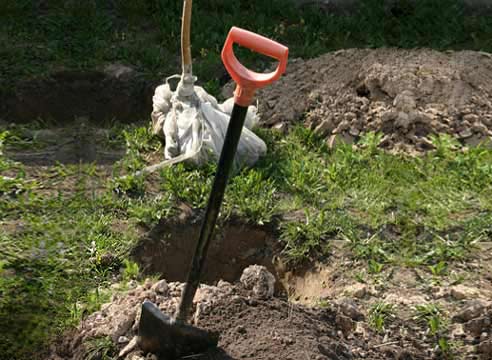

Planting holes for seedlings
Dimensions of planting holes for planting seedlings:
- depth - 0.6-0.8 m;
- diameter - 0.8 m;
- the distance between the holes is 3-5 m.
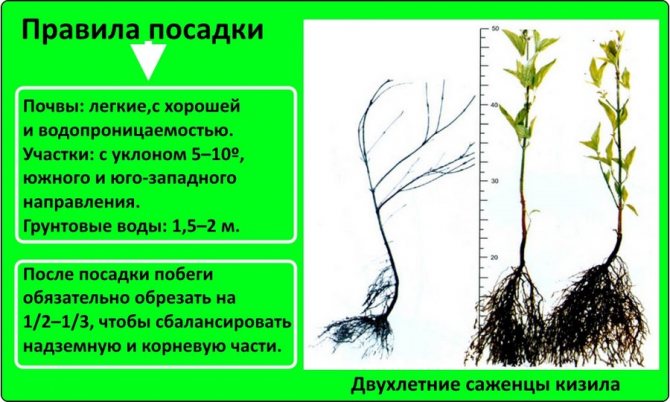

Planting dogwood
Disembarkation is carried out in the fall, in late September and early October. The stake is driven in from the leeward side, and the seedling itself is laid in the ground on the other. The root system is carefully straightened, while making sure that the neck is 3-4 cm above the ground level.
When digging a hole, the upper and lower layers of the earth should be laid separately. This is necessary in order to subsequently combine the upper fertile layer with mineral and organic fertilizers (best with humus).After laying the seedling, the upper enriched soil layer is first laid in the hole, and the soil from the lower layer is used for mulching.
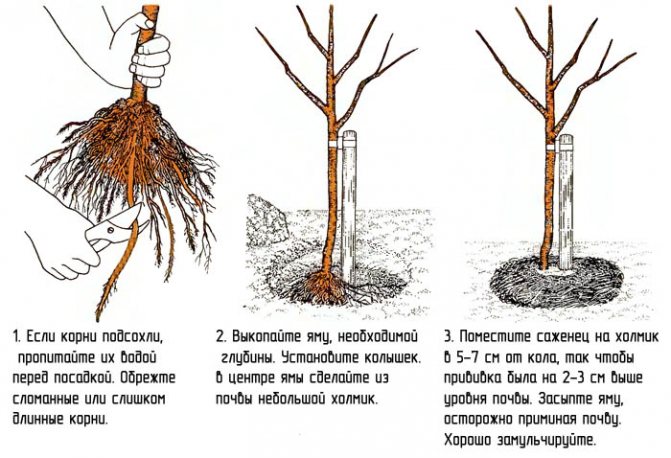

How to plant a seedling correctly
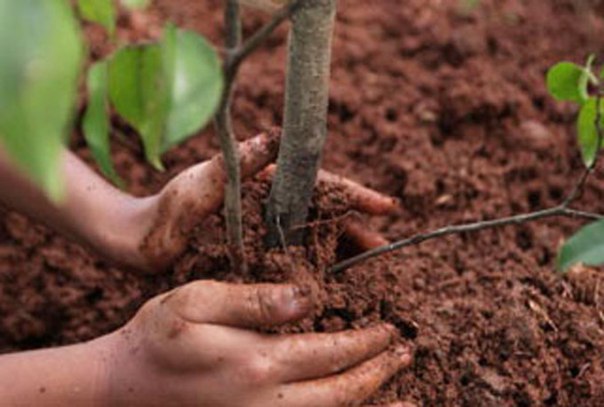

Planting a dogwood seedling
With a shortage of area, it is possible to plant seedlings of different varieties in one hole. After being placed in the soil, both trunks are intertwined. Over time, such seedlings will grow into one plant with a thick spiral-shaped trunk, but with two types of fruits.
The formation of a plant depends on what you want to get in the end - a bush or a tree. In order for the seedling to grow into a neat tree, the lower shoots are pruned for the first 3-4 years. If the plant is not pruned, a sprawling dogwood bush will form. Some varieties are suitable for decorative site decoration. To obtain a beautiful form of palmette, the skeletal branches are bent and fixed with a rope to the pegs, which are then replaced with trellis made of posts.
Experienced gardeners recommend shortening the shoots by a third immediately after planting to balance the root and aerial systems. During the first year, the growth of the seedling does not exceed 0.3-0.5 m, then the plant demonstrates rapid growth, annually increasing by 1-1.2 m.


When to prune dogwood


How to prune dogwood


Secondary pruning of dogwood
Diseases and pests
It should be noted that the dogwood is famous for its resistance to diseases and pests. But sometimes, with improper care, the following diseases can occur:
- Powdery mildew. Its signs are white bloom on leaves and shoots. Treating the tree with colloidal sulfur will help to cope with the disease.
- Rust. Signs of this disease are yellow spots on the foliage. In this case, the tree should be sprayed with Bordeaux liquid.
Of the pests, the dogwood can attack the snailworm. Lime will help to drive it away.
Cornel varieties for growing in central Russia
Dogwood varieties differ from each other in terms of ripening, shape and color of berries. They demonstrate approximately the same yield and frost resistance, so there is no point in highlighting these characteristics. The most popular and recommended by experts are the following varieties:
- Alyosha: ripens in early August or September, the berries are yellow, pear-shaped, large - 6-9 g, sweet and sour.
- Vladimirsky: ripens in August-September, large berries - about 8 g, claret-black.
- Vydubitsky: mid-season variety, small berries, dark red.
- Elena: the dogwood of this variety bears fruit early - in early August, the berries look like lacquered red barrels of medium size with a small bone.
- Firefly: mid-season, pear-shaped berries, 6-8 g, dark cherry, sweet and sour, tart.
- Amber: got the name because of the original color, ripe berries are almost transparent, with a thin skin, weight up to 4 g, mid-season variety.
Photo gallery: popular varieties of dogwood
Dogwood benefits
Cornel is widely used in cooking, confectionery, and is actively used in folk medicine. Due to the presence in its composition of a large amount of vitamins, minerals, useful acids, essential oils, phytoncides, tannins and pectin substances, cornel fruits have many medicinal properties:
- They help to eliminate various problems of the digestive system.
- They improve blood composition, improve blood circulation and help normalize blood pressure.
- Relieve colds, flu and SARS. Improves immunity.
- Help with endocrine disorders and diseases of the pancreas.
- Eliminate joint pain with arthritis and rheumatism.
- In case of severe poisoning, toxins and toxins are perfectly expelled from the body.
- They have a therapeutic effect on various skin diseases.
- Often used in cosmetology as part of various toning masks and creams.
Bark and leaves of dogwood are endowed with useful properties. The wood of this tree also has its value.
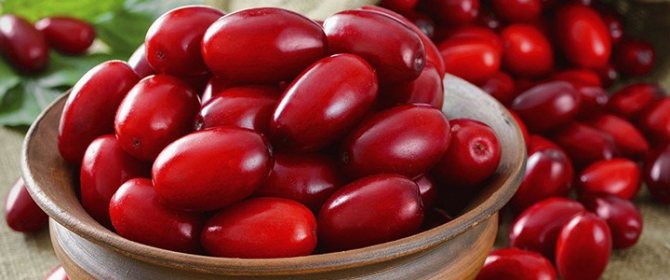

Reproduction methods
Dogwood propagation can be carried out by seeds and vegetatively... The first option is used much less often. This is due to the fact that the seeds sprout for a long time and the seedlings obtained from them require mandatory vaccination, and this is difficult for an inexperienced gardener. The second option involves the use of cuttings and cuttings. It is used much more often.
Read, pear-shaped dogwood: benefits and harms, cultivation techniques.
From the seed (by seeds)
This type of reproduction is fraught with a number of difficulties, but sometimes it is the only way to obtain a high-quality varietal unit. The dogwood seed is very dense, and the seed has several stages of dormancy. In this regard, the planting material planted in autumn gives the first shoots only in 3-4 spring. But using the method of stratification, partially modified natural conditions, you can accelerate this process and get seedlings already 1.5 years after planting.
They perform a similar manipulation as follows:
- Well-ripe fruits are picked up, the pulp is removed. The bones are washed and dried.
- The planting material is folded into a dense linen bag and buried in the soil to a depth of 20 cm.
- Until the onset of frost, this place is watered abundantly every 2-3 days.
- When the snow melts, they begin to water again.
- After a year from the moment of instillation, the bag is removed from the soil.
- For a week, the seeds are dried, then immersed in a growth accelerator for 5 hours. You can use "Epin" (for 100 ml, 2 drops of the substance).
- Seeds are planted in peat pots to a depth of 10 cm and covered with foil. The seedling soil is mixed from garden soil, sand and peat (1: 1: 1).
Video: Reproduction of dogwood from a bone
Periodically, the plantings are aired, removing the shelter, and, if necessary, moistened. After emergence, the film is removed completely. Expose the seedlings on a well-lit windowsill. Until 3–4 true leaves appear, watered abundantly with a spray bottle, periodically adding Epin to the water according to the manufacturer's instructions. After 3-4 leaves appear, they are transplanted into a larger pot. It is best to use peat containers 2 cm larger in diameter. Throughout the year, as the plants grow, transplant is carried out 3-4 times. A year later, you can plant seedlings in the ground.
Did you know? Dogwood
—
one of the most ancient plants on earth. The bones of the culture were discovered by scientists in the settlements of the Neolithic period.
For the winter, they are covered completely with agrofibre. When the seedlings are 2 years old, they are vaccinated in the spring. This will require a cutting from a fruiting plant. It is sharpened on one side in the form of a peg, and a tissue incision is made on the seedling under the active bud, at a height of about 10 cm from the soil. A stalk is inserted into this cut, the wound surface is treated with garden varnish and wrapped with a plaster. The winding can be removed when buds begin to appear on the handle, and the vein of the graft is completely overgrown. The next spring, the grafted shoot is cut off, leaving a stump up to 5 mm long. Immediately treat it with tobacco dust and cover with garden varnish.
Layers
This option is quite simple to implement. In the fall, before the foliage begins to wither, the shoot, located as close to the soil as possible, is bent down and pinned down with metal staples in several places. Then the fixed part of the shoot is covered with soil to a height of 10 cm and until frost is looked after, like an adult plant, by watering.
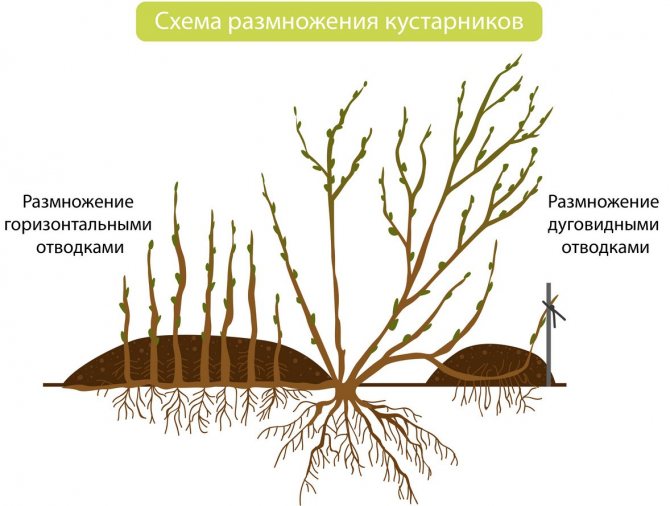

When several shoots hatch from the ground, the shoot must be separated from the mother plant and dug up. The resulting branch with several sprouts is divided into equal parts (according to the number of these sprouts) and planted in pre-prepared places. This method is only suitable for shrub forms.
Cuttings
You can also grow dogwood trees from cuttings harvested in spring or autumn. To do this, when pruning, branches are cut off with a length of at least 15 cm with several buds.The cut site is dipped in water with 3 drops of hydrogen peroxide and covered with a cut plastic bottle. The water is changed periodically, about once every 3-5 days, and activated carbon is added to it (1 tablet each).


When the roots appear, the planting material is rooted in separate peat pots and grown throughout the year, irrigating and fertilizing with growth accelerators. Planting on the site is carried out in spring or autumn (depending on when the planting material was cut) after a year. Dogwood can grow in almost any climate. Its life cycle is at least 200 years, and the fruits are distinguished by a bright taste and a lot of useful properties, which makes it very promising for industrial and private cultivation.
Cornel: territory of distribution, description of the plant and berries
In the wild, dogwood is most often found in the Caucasus. Although its seeds were also found on the territory of modern Switzerland in buildings more than five thousand years old, historians claim that the fruits of this plant were used as food by the ancient Greeks and Romans. Modern cultural forms of dogwood are widespread not only within its natural range, they can be found in the vastness of Central Asia and Moldova, St. Petersburg and the Baltic states. There is no mystery in such a wide distribution of this plant. Cornelian cherry is quite unpretentious and is able to withstand frosts down to minus 30-35 ° C, in addition, an adult plant is resistant to drought and feels equally well in the sun and in partial shade. The dogwood is also presented in the State Register of Breeding Achievements for 2017, and the entire territory of Russia is indicated as the region of admission. And how many dogwoods are spread throughout the gardens without any mention in the State Register!
Dogwood is undemanding to the composition of the soil and grows on poor rocky soils, sandy soils and loam. However, neutral or slightly alkaline light fertile soils with a high lime content are most suitable for him. Young shoots of dogwood tend upward and, expanding, form a multi-stemmed semicircular shrub up to 3-4 meters high or a tree up to 6 meters high. The root system is fibrous.
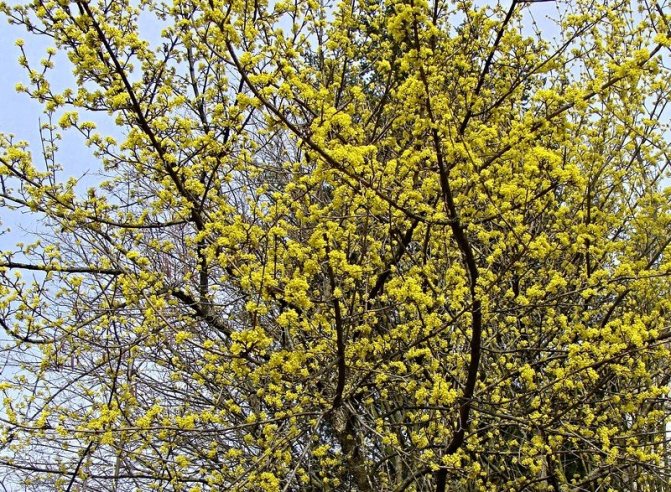

With its bright flowering appearance, the dogwood will decorate any area
Cornel is a very ornamental plant. The yellow corollas of its flowers are collected in inflorescences. They bloom in April and fill the air with a delicate sweetish aroma. The flowering of dogwood lasts up to two weeks, only then leaves appear. Since flowers appear early, this plant has problems with pollinators: for insects, the temperature of + 8 + 10 ° C, when the dogwood blooms, is not very comfortable. In addition, the dogwood needs suitable "neighbors" - it is self-fertile. Wood dogwood or any cultivar of this plant can become a universal pollinator for him.
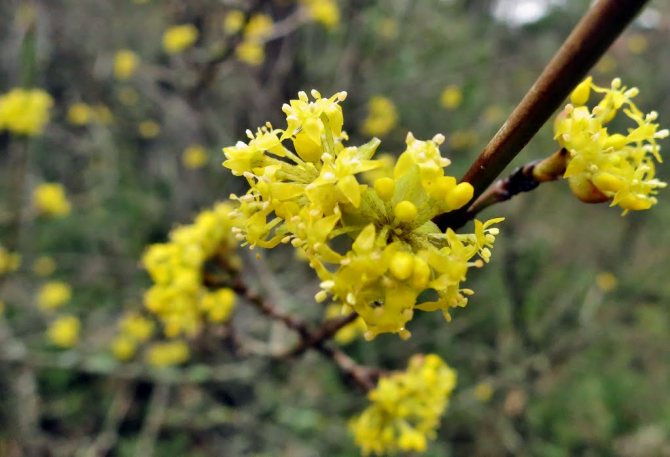

Dogwood flowers are a wonderful honey plant
Dogwood leaves are ovoid, elongated to the top, bright green. The fruits are usually red, but there are varieties with fruits that are white, yellow and even maroon, almost black. The shape of the berries in some varieties is elongated, pear-shaped, in others it is spherical. Weight in the range of 1-9 g. The bone is oblong, easily separated, makes up 12-30% of the weight of the fruit. Ripening of berries occurs at the end of August or September.
In terms of vitamin C content, dogwood berries are even superior to lemon, so decoctions of its fruits and leaves are used in medicine as an anti-inflammatory and tonic. An antiscorbutic effect is also attributed to this broth. And in some regions of our country, there are legends claiming that dogwood berries can cure any disease.
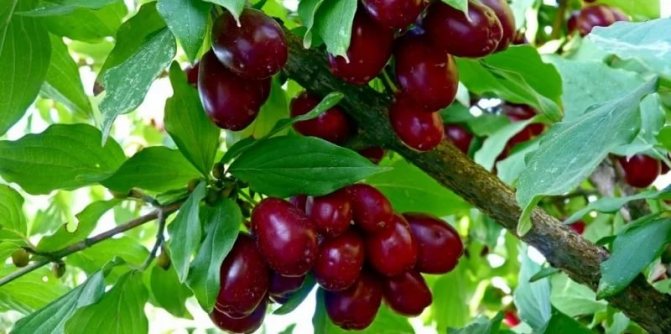

Dogwood fruits are usually dark red in color.
The taste of dogwood fruit cannot be confused with anything: it is slightly astringent, tart, sweet and sour or sweet (depending on the variety - as well as the degree of juiciness). The flesh of the fruit can be uniform or grainy. The only thing that does not depend on the variety is the unique aroma of berries. A description of how they are applied could form a separate chapter.Cornel is consumed fresh, jams, compotes, jelly are cooked from it, jelly, marshmallows, juices are prepared. The berries are dried and added to tea, like the leaves, and the seeds are used as a substitute for coffee. And what to hide, cornelian vodka is quite popular, which retains the unique aroma of berries and is considered exquisite.
Cornel is not a fast-growing plant: grafted seedlings enter the fruiting period by the fifth–sixth year. But the dogwood is fruitful: 20-25 kg of fruits are harvested from ten-year-old trees, and from twenty-five-year-old trees to a centner.
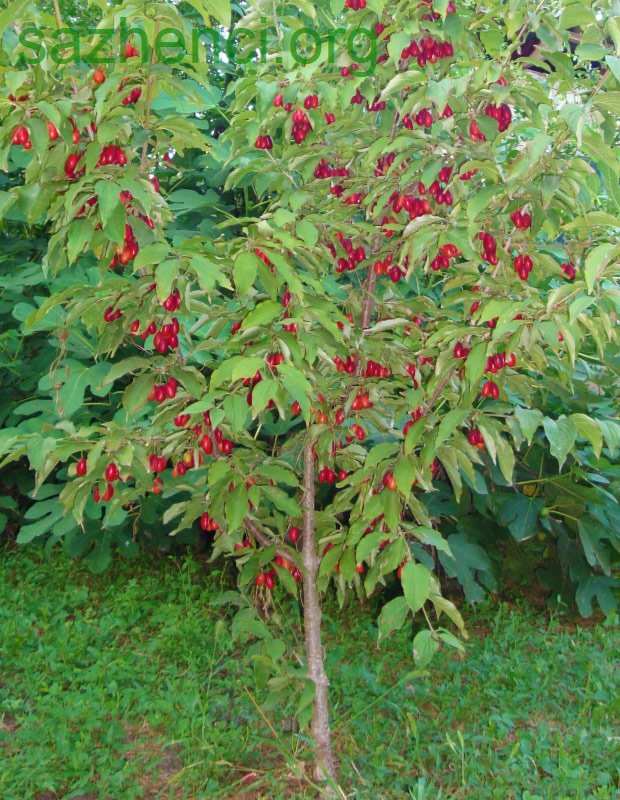

A young dogwood tree is already bearing fruit
Dogwood trees are long-lived, their age can exceed one hundred or even two hundred years. Therefore, by planting such a tree on his site, the gardener can be sure that his grandchildren and great-grandchildren will be able to feast on these berries.
"Who is" dogwood?
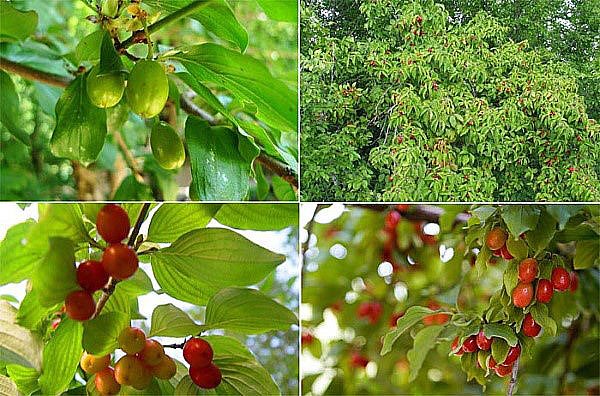

Dogwood is a fairly tall shrub, the height of which depends on the climate in which it grows. On average, the "growth" of bushes is about 3 m, although there are often taller 8-meter comrades, more like trees.
Regardless of the species, woody or bushy variety, in the "childhood" age all plants actively grow young shoots, painted in yellow-green color, but, "growing up", the branches are covered with gray wrinkled bark, which turns red over time. The crown of the bush is round or in the form of a pyramid, and the leaves are elongated and have a sharp tip.
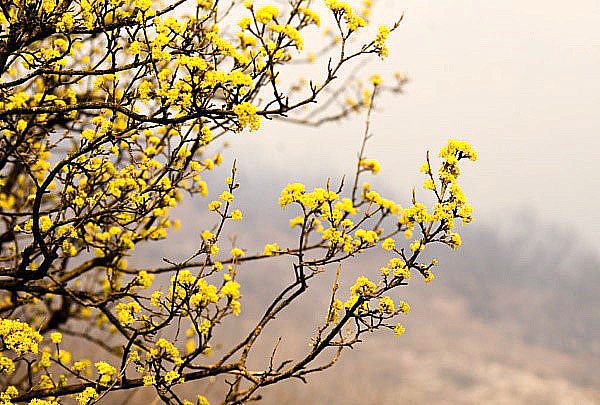

The leaf plate is painted on top in a bright green light with a slight gloss, while on the bottom it is lighter and more dull.
Blooming dogwood is no less decorative: yellow lush umbrellas of inflorescences bloom in early spring, in March, and before the leaves peep out of the buds on the branches.
Timing of fruiting
In the southern regions, dogwood actively begins to bloom in March-April, and the first fruits appear by mid-August. The fruit is fully ripe in early September, but true connoisseurs of this berry love to pick it after the first night frosts.
In mid-latitudes, you can eat dogwood no earlier than mid-September. And in early October, under the influence of real frosts, the berries crumble abundantly, so by this time they usually have time to harvest the crop.


The flowering period of this plant begins earlier than other fruit trees and shrubs. It starts in March and lasts until mid-April, if the daily air temperature is in the range of 5-10 degrees. The average flowering time is 14 days.
The flowers of the plant are colored bright yellow. They are pollinated by bees and wind. It is recommended to plant several plants at once in order to get a crop regularly. The first crop can be harvested in late summer and early autumn. The shape of the fruit depends on the variety of the plant. The fruits are red, yellow or pink in color.
Powerful branched rhizomes of the plant lie at a depth of 1 m from the ground level. The main roots are located at a depth of half a meter.
Frequently asked Questions
You can often hear the questions: "How to grow a dogwood?". Our gardener answers this and other questions.
Illona writes to us the following: “Good afternoon. I need advice. I can't figure out how to grow a dogwood. I have two dogwood bushes. Moreover, they have been growing next to each other for several years. I also have an apiary on my garden plot. But the most interesting thing is that the ovary does not linger on my plants. Once, however, one berry remained at the very bottom. But it was stolen either by insects or by pets. Soon the bushes will bloom again. I'm thinking of wrapping them in agrotechnical cloth. Maybe, in this way, I will be able to create a microclimate that will help preserve the ovary. Do you think this will help or not? "
Answer: “For a plant to be pollinated, several conditions must be met: the presence of bees, wind, sunny weather and a pollinator tree. I believe that in your case you need to do the following:
- Plant another dogwood of a different variety.
- To attract more insects, it is recommended to spray the plant with a weak honey solution during the flowering period.
- It is best to wrap the tree with agrofibre at night. And then, this must be done if night frosts are predicted during the flowering period. For pollination, such a wrap will not help.
In doing so, remember the following:
- the plant bears fruit only for 7–8 years;
- dogwood does not bear fruit in clay soil ”.
Read also Allergy to carrots in a child photo
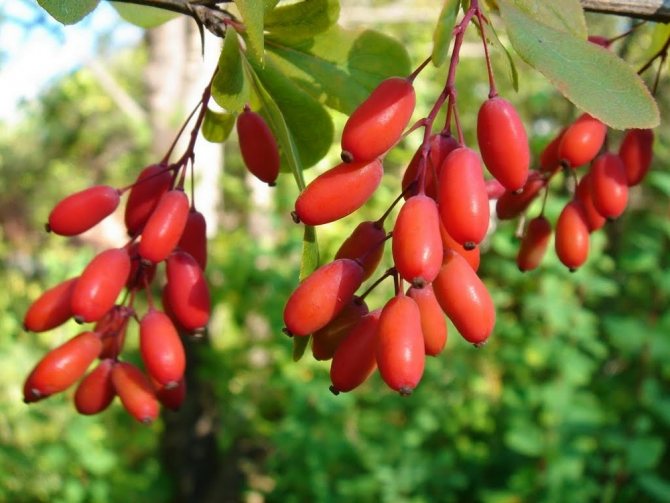

Julia asks: “Tell me, please. About three years ago I planted two dogwood bushes. They started without any problems, but for some reason they grow very slowly and do not bloom. What should I do?".
Answer: “Pay attention to the soil. The plant will not grow in clay or in full shade. It is necessary to transplant it. And, in general, I want to say that in the first years these shrubs do not grow quickly. Most likely it is too early for your plants to bloom. Very often, dogwood begins to bloom after seven to eight years, if the plant is not an early variety. "
Igor asks: “I recently bought a dogwood seedling. The seller told me that it is still necessary to buy a sexton. Explain to me what it is? Is it really necessary? After all, it stands the same as the seedling itself. "
Answer: “Usually these plants are planted in pairs. Of course, self-pollinated species have been bred to date. But I often hear from people that these varieties do not always bloom. I would recommend that you buy a second tree anyway. With its help, pollination is guaranteed. The sexton can easily be the second plant. "
Is the berry sweet?
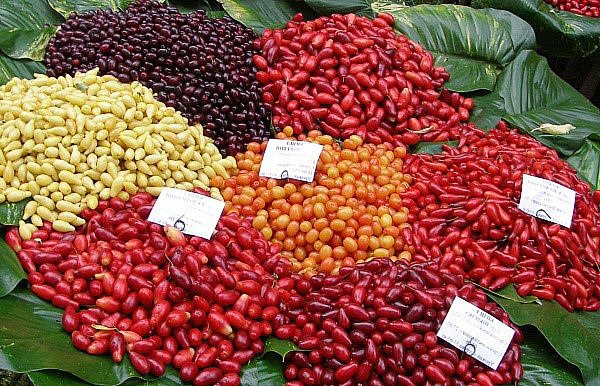

At the end of summer - at the beginning of autumn, elongated berries begin to ripen on the bushes: they are small, up to a maximum of 4 cm in length and up to 8 g each in weight, but with very tasty and juicy pulp. The taste is dominated by sourness and a tart note is clearly felt. It has been noticed that the berries left on the bushes during the autumn frosts become sweeter.
The color of the berries depends on the variety, but they are mostly bright red, although breeders have bred yellow, white and different shades of red dogwood. All of them are very tasty and extremely healthy due to the rich composition of trace elements. Excellent compotes and preserves, wines and syrups are prepared from dogwood berries, as well as dried, dried and frozen. In addition, dogwood has a number of medicinal properties, which makes it an indispensable aid in the treatment of many diseases.
To prepare berries for future use, it is better to pick them when the dogwood is just beginning to ripen. Folded in boxes or wicker baskets, green berries ripen right in them.
Dogwood in the suburbs
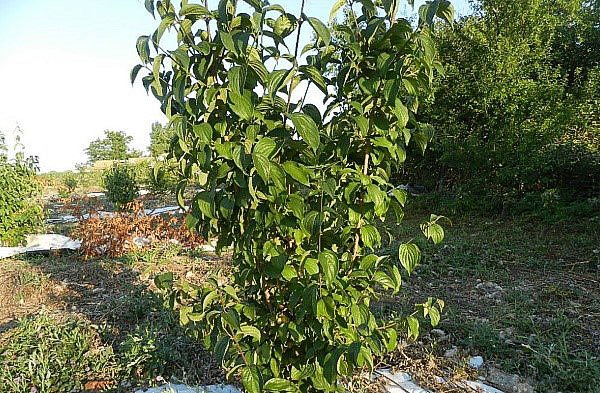

Spring planting of seedlings is also recommended when growing dogwood in the Moscow region, where the winters are also cold. But local gardeners can boast of an abundance of snowfalls, which simplify measures to protect shrubs from frost: if the average winter temperature is up to 30 degrees below zero, it is enough to “barricade” the bushes with a snowdrift.
Of the frost-resistant varieties that grow well and bear fruit in the conditions of the Moscow region, it is worth noting:
- Nikolka. The dark red sweet berries ripen in early August.
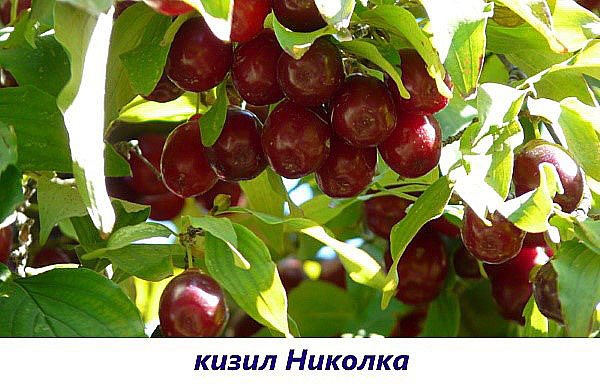

- Grenadier. High-yielding variety (up to 45 kg of berries from one bush). Red elongated berries ripen in the first decade of August, taste sweet and sour.
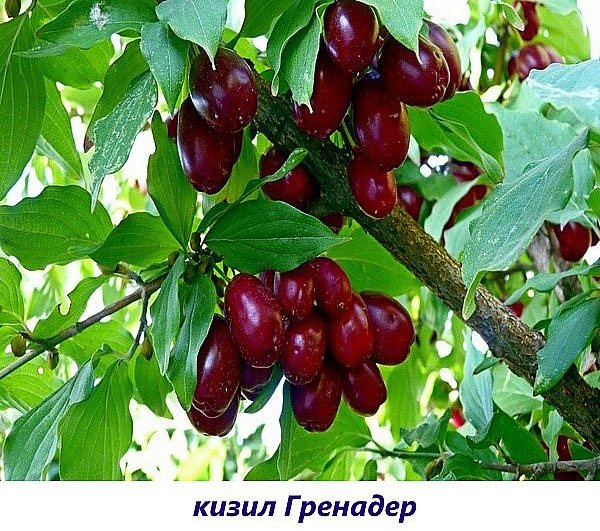

- Elena. At the end of August, you can pick dark red, slightly oval, sweet-fleshed berries.
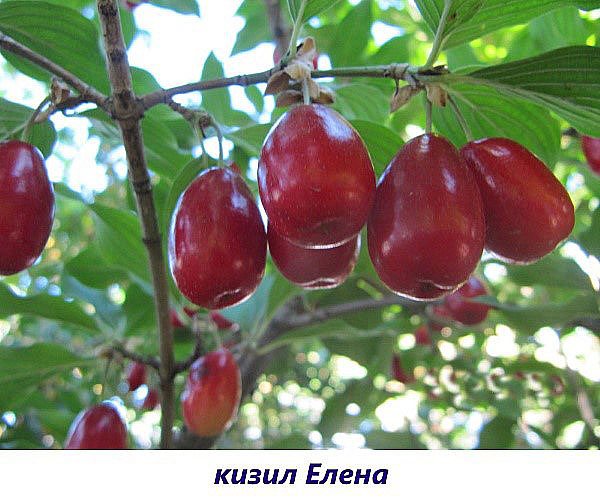

The benefits of dogwood berries
In one berry, there are many substances necessary for health: fructose, glucose, organic acids, nitrogenous and coloring substances, essential oil, vitamins C and P and phytancides.
The harvest from this shrub is allowed to be consumed when:
- gout;
- anemia;
- hemorrhoids;
- dysentery;
- typhoid;
- diseases of the gastrointestinal tract;
- joint diseases;
- skin ailments.
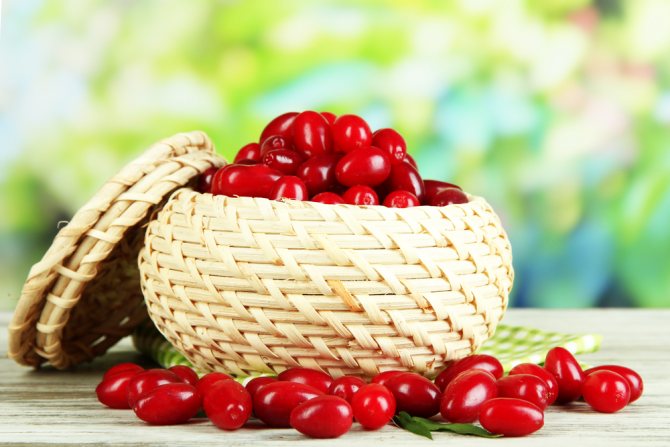

They also have the following actions on the human body:
- choleretic;
- diuretic;
- antiscorbutic;
- bactericidal;
- antipyretic;
- anti-inflammatory.
The berries contain pectin, which helps cleanse the body. It removes oxalic and lactic acid. With the help of biologically active substances that are included in their composition, it is possible to stabilize blood pressure, prevent sclerosis, eliminate headaches and stabilize intracranial pressure. Also, the fruits strengthen the walls of blood vessels, make the capillaries less fragile. It is advisable to use it in case of venous insufficiency, inflammation of the veins and edema of the legs. Fruits improve appetite and have a positive effect on the metabolic process in the body.
Pollination
Dogwood has cross-pollination. This means that there must be several different varieties on the site. The buds can be pollinated on their own from the inside, but fertilization will not occur. All varieties are equally well suited to each other as pollinators, since regardless of the timing of fruiting, they will bloom in the same period. The difference can be minimal and amount to 3 days, which will not affect the quality of fertilization in any way.
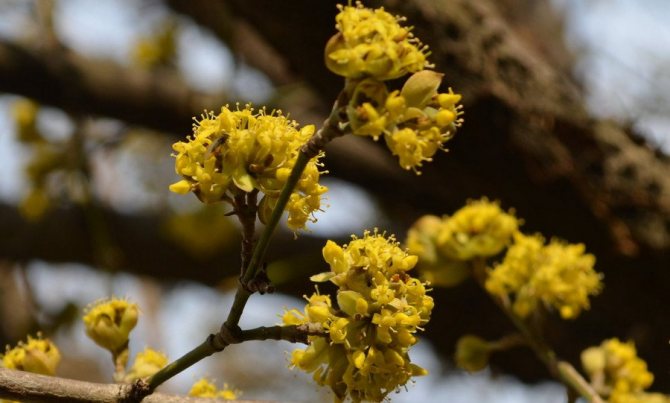

Testimonials
Since the late 90s, dogwood has been growing, brought from Pyatigorsk to the Bryansk region. During this time, the temperature dropped to minus 34. The apples and pears froze. Dogwood, at least that, only increases the harvest.
SergeyKrivonosov
I want to draw the attention of those who are just going to plant a dogwood to the fact that the plant is self-infertile. For the harvest, you need to plant at least two bushes or negotiate with neighbors to plant them.
serde
We decided to grow dogwood ourselves, we like wine and dogwood jam, but we have already made several mistakes with the "grandmothers" in the bazaar, so we decided. Despite the existing opinion that dogwood grows poorly in the middle lane or does not bear fruit, our friends proved the opposite, which influenced our desire to learn from their experience. The landing site was chosen slightly shaded. The land was prepared in the fall: they dug a planting hole with a diameter of about 1 meter and a depth of 80 cm, brought in a little new land mixed with fertilizers (organic and mineral). For the winter, we covered the hole with a film, and at the end of February we opened it. At the end of March we decided to plant our dogwood. They took humus and compost, mixed and divided into two parts. One part was mixed with soil and the hole was half filled, making a small mound. They took a seedling, set it on a mound and covered it with the rest. A young plant requires good watering (30–40 liters). The near-bore circle was covered with sawdust so that the moisture would not evaporate. Our friends recommended that you trim the shoots by 1/3 to balance the root and aerial parts. We already have leaves here and there. For those who are interested, we took the Primorsky dogwood, it is believed that it is winter-hardy.
Elizabeth
I have been growing these delicious and healthy fruits for a long time. Actually, I have already tried all the methods of growing dogwood - both from the stone and by cuttings. My dogwood has grown and formed a hedge. I cut it at a level of 70-100 cm. The harvest of this wonderful, I will not name it otherwise, the berries I have, as a rule, are very good. The wife makes jam out of it and spins compotes for the winter.
Vakhtang
There are enthusiasts who grow dogwood in the Moscow region. At the same time, even harvesting. Of course, these are not the same southern crops. I will not venture to say that there is already some sort adapted for the middle lane, but I strongly advise you to plant the seeds in the fall, since there is such a desire. It's great to see self-planted plants grow. You just need to take into account that the period of stratification of cornel seeds is more than 800 days, so seedlings should be expected for two winters, but rather all three. Try it, because how many unusual things are already growing in the more northern regions!
Anton
For central Russia, the dogwood is no longer an overseas curiosity and not a quivering stranger in need of greenhouse conditions.This wonderful plant with aromatic and healthy berries can be found in many horticultures and private homesteads. And the number of his fans only promises to grow, because the dogwood is resistant to cold weather, is ready to grow on almost any soil and bear fruit for up to a hundred years - why not an ideal tenant for your garden?
Subtleties of outdoor care
Dogwood is a very unpretentious culture. For successful fruiting, only basic agricultural techniques are needed. Plant care includes regular watering, feeding and pruning. It is also necessary to take into account the subtleties of pollination, without the knowledge of which it will not be possible to harvest a tasty crop.
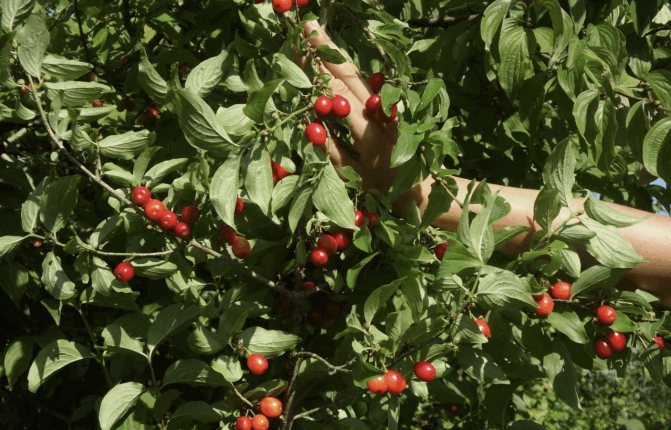

Watering
The crop is drought tolerant and can withstand high temperatures. At the same time, shrubs need abundant watering.... With a lack of moisture, the berries wrinkle or fall off. Lack of watering affects the overall yield.
Water the plants as the soil dries out. Always keep the soil slightly damp whenever possible. Loosen the row spacings after each watering. Loose earth provides high breathability.
Important! Loosen the soil a maximum of 10 cm deep. Otherwise, you can damage the root system.
Top dressing
Cornel responds well to feeding. Organic and mineral preparations can be used.
An approximate scheme for applying fertilizers under a bush is as follows:
- in early spring before the beginning of the growing season - 40 g of nitrogen, 20 g of potash;
- when laying fruit buds (May - June) - 10 liters of slurry;
- at the end of the growing season in the fall - 10 kg of compost and 90 g of phosphorus agents.
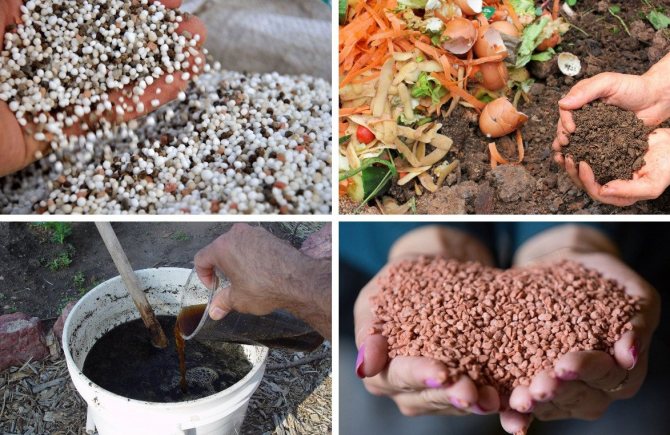

Pruning
In the early years, it is necessary to form a skeletal backbone. As a result, you should get a shrub on a trunk with a height of approximately 0.6 m. The main branches are left no more than 5-7.
Strong stems are used as skeletal shoots. During the formation period, it is necessary to remove all branches, except for skeletal ones, taking into account the root growth. At 2-3 years of age, when the crown is formed, you can resort to sanitary pruning.
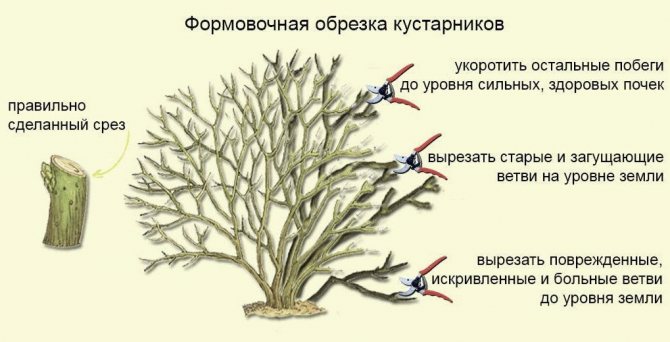

All pruning procedures are carried out before the start of sap flow or at the end of the growing season.
Within its framework, the following are removed:
- shoots thickening the crown;
- root shoots;
- branches on the trunk;
- broken stems;
- parts of the plant affected by diseases.
Video: pruning and growing dogwood
Pollination
Dogwood is an almost self-fertile species. Bushes need cross-pollination. Planting together promotes fruit set. Planting several varieties will allow you to get more harvest.
Landing
- Dig holes 50 * 50 * 50 in size. A layer of drainage material 15 cm thick is poured onto the bottom of the pit. It can be pebbles, broken brick, expanded clay.
- The dug soil mixed with wood ash, humus and mineral fertilizers is poured over the drainage layer.
- A seedling is placed in the center of the pit, and the roots are carefully straightened. Fill the hole with soil so that the root collar of the seedling is at ground level.
- The soil is tamped so that there are no voids left, and it is well watered with lukewarm, settled water.
- The root zone of the seedling is mulched using coniferous needles, straw or hay with a layer of 10-14 cm.
How to plant a seedling correctly?
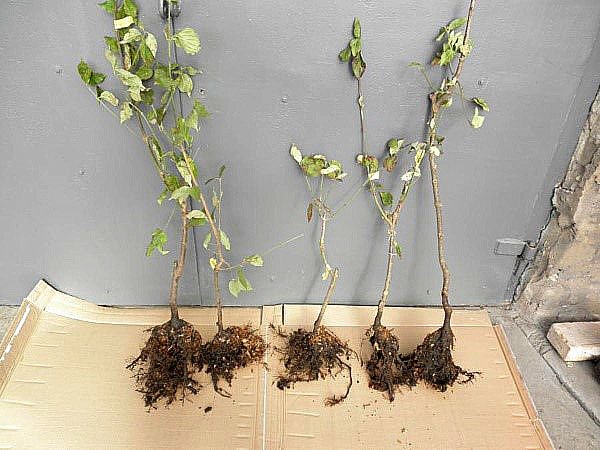

The most convenient way to grow dogwood is with seedlings, which can be purchased at a local nursery, where there is always a large selection of zoned varieties. What does a dogwood seedling look like? It should be:
- not older and not younger than 2 years old:
- with a well-developed root system;
- up to 1.5 m high;
- with a stem diameter up to 2 cm;
- with at least 5 mature skeletal branches.
The optimal planting time is autumn. For a seedling, dig a planting hole 60 * 60 cm in size.Mix the top layer of soil with mineral fertilizers and humus and cover the bush, deepening the root collar no more than 3 cm above the soil level (after the earth settles, the collar should be equal to it).After watering, mulch the trunk circle and it is advisable to shorten the shoots near the bush, leaving 2/3 of their length.
Planting dogwood must be carried out in pairs, at a distance of 3 to 5 m from each other. This is necessary for pollination, because in early spring, when the perennial blooms, it is still cold outside and the bees have not yet begun their work.
Propagation by cuttings
This method is a little more complicated, but it is also quite affordable. You can cut both green and lignified shoots.
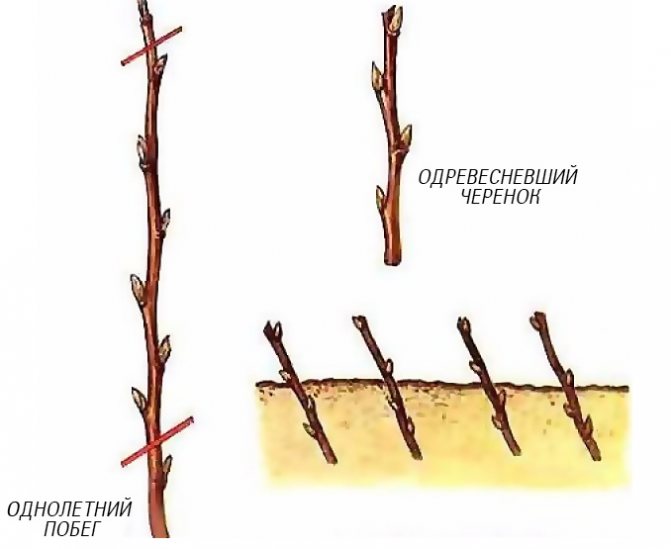

Operating procedure:
- In the summer (in June), cuttings are cut from annual shoots, so that each has an apical bud and two or three leaves. The lower cut is made directly under the lower kidney.
- The lower sections with the kidneys are soaked in a root-stimulating solution prepared according to the instructions (for example, heteroauxin) for 4-6 hours.
- Best of all, rooting of cuttings occurs in specially prepared greenhouses, in which shading is organized in the hot midday hours. In such greenhouses, soil is poured with the following composition - drainage - 8-9 cm, a mixture of peat and sand - 13-14 cm, sand - 1.5-2 cm.
- Cuttings are planted at a periodic distance of about 30-50 cm. Rooting can be expected in 1.5-2 months.
- The cuttings are watered and weeded. After the root is formed, it is transferred to a permanent place.
Choosing a landing site
For the healthy state of the dogwood and for it to bear fruit well, in addition to the timing, it is very important to correctly determine the place for a successful planting of the dogwood.
Where is it better to plant on the site. Requirements for soil and lighting.
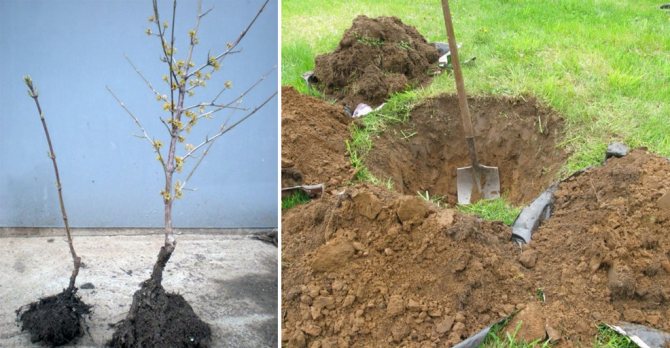

Cornelian cherry is very easy to grow in the country, because it is not particularly picky about lighting, easily tolerates partial shade and "gallery" - as a rule, it is grown along the edge of the plot, or even a hedge is made. In the conditions of the Middle zone and in the Moscow region, it is better to grow rather thermophilic varieties from the southern or southwestern side, this will to some extent save them from the cold.
The plant is also loyal to the composition of the soil. Planting dogwood in the open field fully justifies the work, but you can get a full harvest only on good plots with neutral, fertile soil.
What to plant next to the dogwood. Neighborhood. At what distance to plant from each other
For our gardeners, 2-4 fruitful varieties will be enough, which in a few years will cover the family's need for vitamin fruits. You can place the plant, as already mentioned, along the perimeter of the site, in the company of other fruit bushes.
It has good compatibility with other trees, but, remembering the powerful development of the aboveground part of the plant and its root system, it is necessary to maintain a distance, so the planting scheme is as follows - the bushes / neighboring trees should be no closer than 2.6-3 meters away. The same distance must be maintained between the seedlings of the dogwood itself.
Landing dates
Dogwood can be planted in fall and spring like any perennial plant. It is important to approach this from the standpoint of logic and experience, because the correct planting and transplanting of dogwood in the open field and the timing of planting are the key to future yield.
When is the best time to plant dogwood
There are completely different opinions on this topic among gardeners, someone recommends an early autumn planting, a number of experts insist on a spring planting. However, the following can be traced in scientific articles:
- If the planting takes place with root suckers, it is simply necessary to plant them in the fall, since the buds in the spring, having blossomed, will quickly begin to suck out moisture, and weak roots will not cope with its intake. The same applies to reproduction by layering and cuttings.
- If the formed container plant - planting is universal, it can be planted in any season. However, it must be borne in mind that the dogwood is a slow growing plant and very poorly grows the root system. Therefore, the spring planting must occur earlier - otherwise the growing plant may die from lack of moisture.
Planting in autumn
It is in the fall that many gardeners plant dogwood.Planting dogwood in the fall is a good time if a good, strong seedling is selected. Dates are selected, trying to coincide with the beginning of the poplar leaf fall.
Landing order:
- Remove the leaves to the maximum.
- Put the plant in a container with water (if it is not a container) for two to three hours.
- Then pull out the plant, shake it and dip the roots in a clay suspension.
- In a pre-prepared hole - on an elevation made inside - put a tree, distribute the fibrous roots evenly.


- Gradually sprinkle with soil, pressing lightly, in layers. Make sure that the root collar does not go deep (at least 5 cm above the soil).
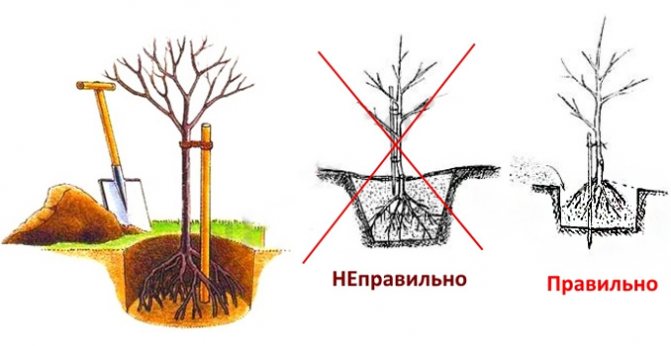

- Make a hole in a circle of the hole and water the planted seedling very abundantly.
- Sprinkle with mulching material and tie to a peg.
Planting in spring
Practically no different from the autumn, but the seedling is planted before bud break and in the soil warmed up by the sun.
If you follow the lunar calendar, then it is better to plant seedlings on the waning moon... As a rule, in May these are the first six to seven days of the month and the last 3-4.
How to choose the right seed?
You do not know which dogwood seedlings to buy? Then you need to familiarize yourself with the following recommendations. When buying seedlings, you need to pay attention to the condition in which they are rhizomes:
- they should be free of signs of disease;
- preference should be given to seedlings on which there are two or three main root branches, the minimum length of which is 25-30 cm;
- rhizomes must be moist and not windy;
- the bark should not be shriveled, and the branches should not be whole and strong.
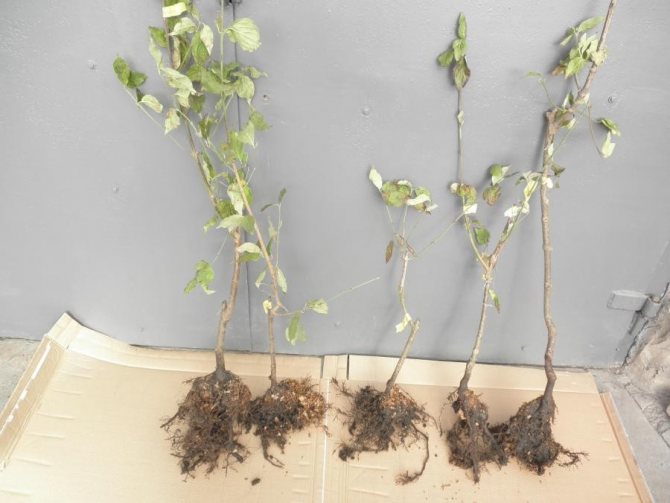

How to grow dogwood. Photo
If the purchase of seedlings occurs in the fall, then it is recommended to carefully remove the foliage on the branches. In this case, care must be taken not to damage ovary.
It happens that the acquired seedling cannot be planted immediately. In this case, it is recommended to bury it in the shade. To do this, you need to do the following:
- Dig a slightly elongated groove, shallow in depth. At the same time, it should be tilted to the south.
- The seed must be placed in the pit at an angle.
- The plant is covered with a substrate in such a way that all the roots and half of the seedling are covered.
- After that, the shrub must be watered abundantly. This way you can store the seed for one month.
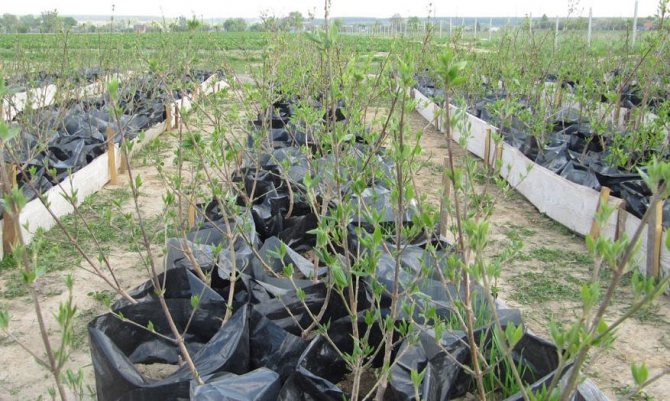

The preparation of planting material is as follows:
- it is necessary to remove all broken, unhealthy, dry rhizomes and branches;
- so that the roots of the plant do not dry out, it is recommended to coat them in a clay mash before planting.
Pest control
Of the pests, the most dangerous enemy for the dogwood is the worm. It is a sucking parasite that feeds on the sap of foliage and shoots. In the process of vital activity, the pest releases honeydew (sticky liquid), which covers the leaf, which interferes with normal photosynthesis. If it is found in the garden, it is necessary to immediately carry out a sanitary pruning, and then treat the vegetation with the preparation "Fufanon", according to the instructions.
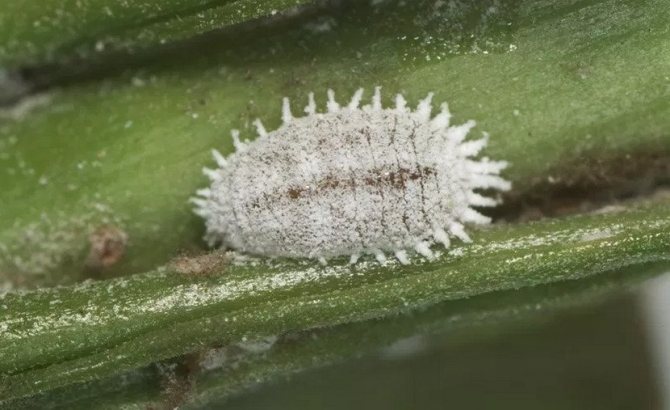

Dogwood in the gardens of Belarus
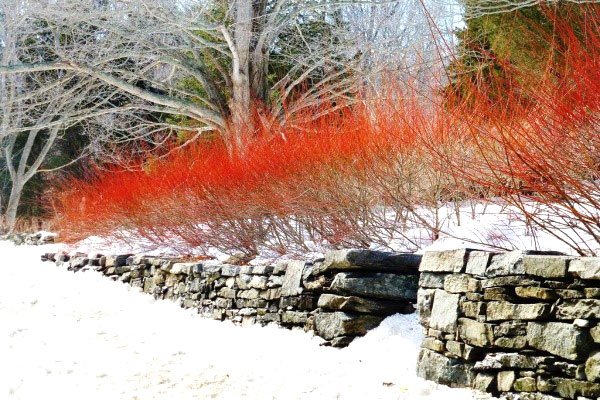

Separately, it is worth mentioning the cultivation of thermophilic dogwood in Belarus - the local cold climate requires a special approach, in particular, it is better to start planting seedlings in spring, so that they have time to get stronger by winter. Those plants that are formed in the form of a shrub survive the winter best, but even they need to be covered if the average temperature in winter drops below 30 degrees below zero. To do this, the shoots are bent to the ground and the bush is covered with spruce branches.
As an orchard and berry crop, the main purpose of which is fruiting, on the territory of Belarus, such early varieties of dogwood with ripening at the end of summer have proven themselves well:
- Coral Stamp. Unusual dark pink berries with an orange tint ripen in the second half of August.
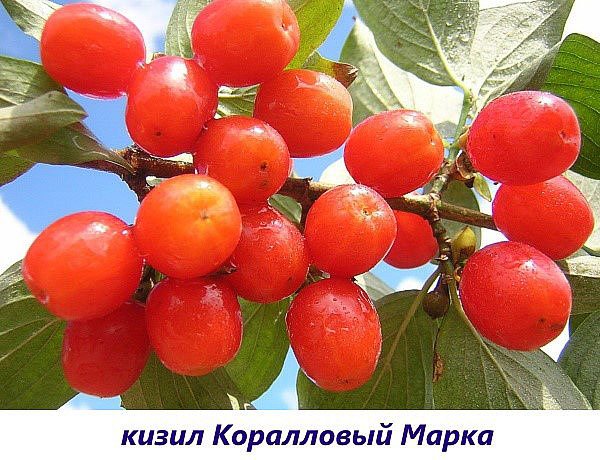

- Elegant. The first harvest is already at the end of July.The cherry-colored berries are in the shape of a bottle with a narrow neck and do not crumble until frost. Differs in low growth (no more than 2 m in height).
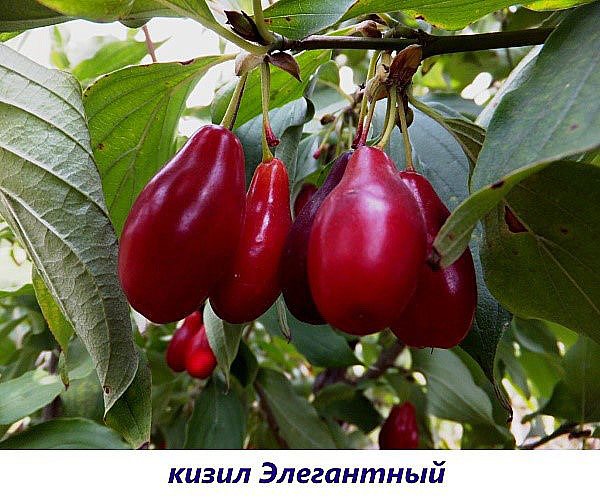

- Mid-season variety Vladimirsky. One of the largest-fruited species of dogwood, the weight of one almost black berry is about 10 g, the shape is rounded, slightly flattened. Ripening occurs in the third decade of August.
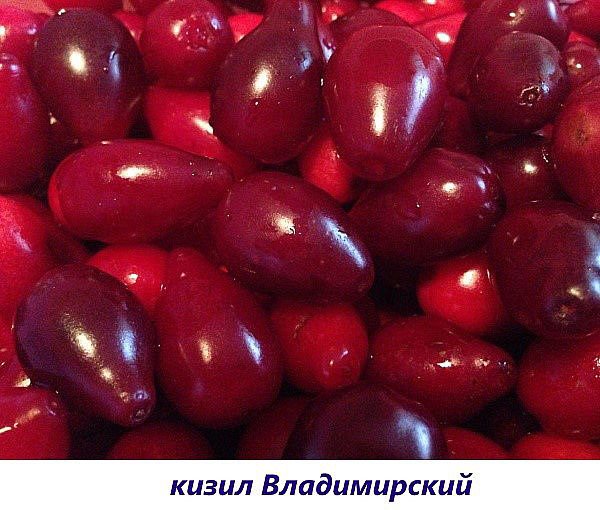

What can be planted next to the dogwood
The good and bad neighborhood of plant crops is a separate science called allelopathy.
- According to botanical research, the neighborhood is good for dogwood:
- cherries;
- walnut;
- apricot.
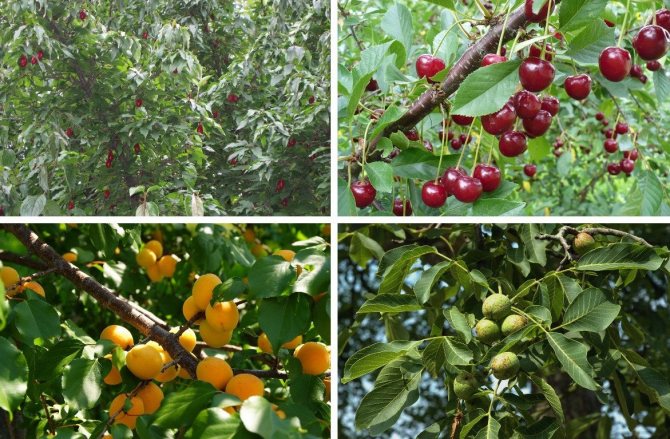

Also consider the peculiarities of crop pollination. The ideal neighbor for dogwood is another plant variety, thanks to which berries will be tied on the bushes.
How to prepare a seedling?
During the acquisition of seed, attention should be paid to the root: the more powerful it is, the faster the plant will develop. Weak, chapped, thin roots with obvious signs of soreness should be treated with concern. You need to purchase powerful seedlings with 2-3 root branches at least 30 cm in length... The bark on the trunk should be intact and the branches intact.
To fully ensure the viability of the plant you like, you need to slightly cut the bark. If the incision is green - means the choice is correct, if brown - you will have to continue searching for a suitable dogwood.
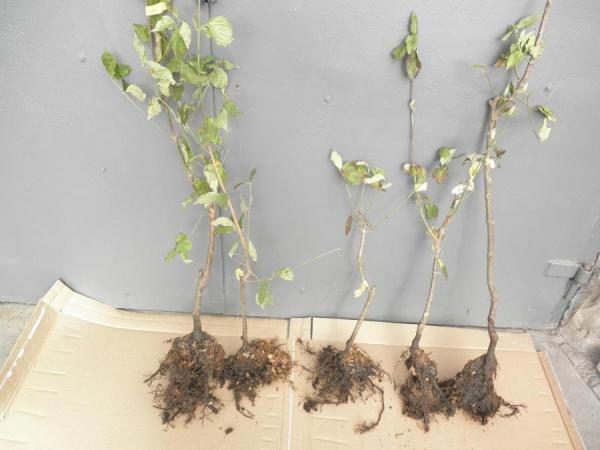

Before planting dogwood seedlings, they should be placed in water for several days.
The seedling rhizome should be well moisturized. In the case of long-term transportation, it is wrapped in a damp material and placed in a plastic bag. If the roots have dried up during the transportation period, they should be placed in water for several days before planting.... If, after the purchase, it is not possible to immediately plant a seedling, it is added dropwise at an angle in a shaded place. It is important here that the soil covers all the roots, as well as half of the seed. A richly watered plant in this form can be stored for a month.
Growing dogwood and caring for it in central Russia
Cases of diseases or damage to dogwood by pests on the territory of the Moscow region and central Russia are practically not described. And recommendations for care are reduced to timely abundant watering and pruning. Watering for dogwood is important: with a lack of moisture, the fruits become less juicy, the taste is mild. Therefore, the plant must be watered regularly, especially in summer (40–50 liters once or twice a week in the absence of rain).
Young dogwood seedlings grow slowly, but then the growth becomes more intense, and some plants are thickened - they need pruning.
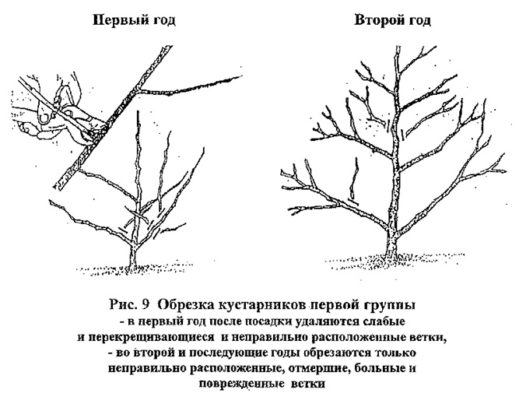

If the dogwood needs to be shaped like a bush, then only the growing inward or dry shoots are cut off.
It is with the help of the pruning procedure that the gardener can give the dogwood the shape of a bush or tree. If the bush shape is preferred, remove only misplaced, dry, inward-growing branches. If the dogwood needs to be shaped like a tree, shoots located below 50–70 cm are removed in the first years after planting, and then they maintain the resulting shape by cutting the dogwood according to the traditional scheme for fruit trees.
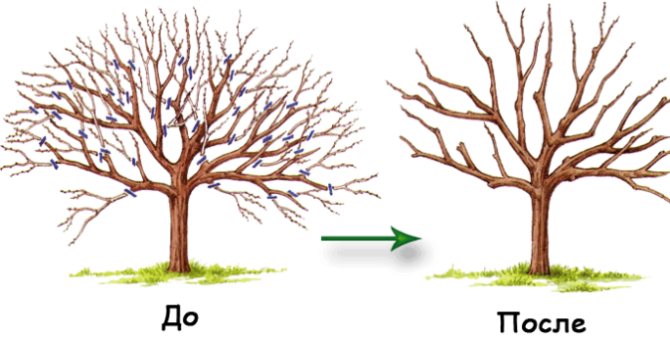

With regular pruning, dogwood can be easily shaped into a tree
Loosening the soil under the dogwood is carried out carefully, no deeper than 10 cm - do not forget about the superficial location of the roots. As for fertilizers, gardeners do not insist on their introduction, since under natural conditions the dogwood grows and bears fruit even on poor soils. However, if there is a desire to fertilize dogwood, it should be taken into account that nitrogen-phosphorus fertilizers are applied in spring, and potash fertilizers - in summer or autumn.
The main factor complicating the cultivation of dogwood in central Russia is recurrent spring frosts. The plant can only be protected from them by smoking (processing plantings with smoke in the morning). Another problem: with early flowering (and in dogwood it is always early), there may be no pollinating insects. However, when planting several plants in one area, this problem is perfectly solved.
Choosing the perfect dogwood seedling
An ideal planting material is a large-fruited annual. The younger the plant, the better it adapts to the characteristics of the site: soil composition, illumination, neighboring plants, climate. Choose dogwood seedlings from local horticultural nurseries... They are already adapted to local growing conditions.
Seedlings with a closed root system (in containers). For normal life, the dogwood tree needs a special microflora on the root system.
It is formed in the first year of life in a nursery. If the earthen lump with beneficial bacteria is separated, the dogwood will freeze in one place for several years.
Outcomes
To obtain a high yield of dogwood, the following important points must be observed when growing it:
- Choose the right landing site.
- Choose healthy seedlings with closed roots.
- Land according to the recommendations.
- For pollination and fruiting on the site, at least two trees should be planted side by side.
- Water, feed and prune trees in a timely manner.
- Loosen and mulch the root zone regularly.
- In case of detection of diseases and pests, take the necessary measures immediately.
- Cover young trees in harsh winters.
Dogwood frost resistance
Most varieties of dogwood can withstand temperatures down to –30 ° C. At lower temperatures, the shrub must be covered for the winter. Otherwise, the tops of the shoots may freeze. Young plants mulch in late autumn. A layer of humus or peat (15 cm) is used as mulch.
Before frosts, the bush is covered with a cardboard box, which is pressed with a load to the ground. Straw or wood chips can be placed in the box to keep warm.
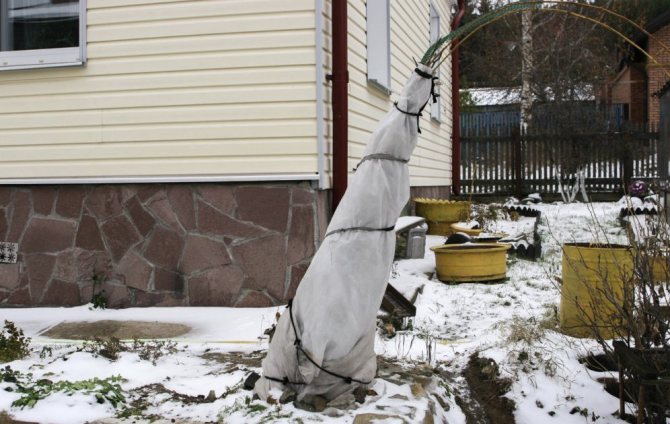

Adult bushes with developed shoots must be tied with twine or nylon rope. The connected branches are wrapped in spunbond or agrofiber.
Where can you find dogwood?
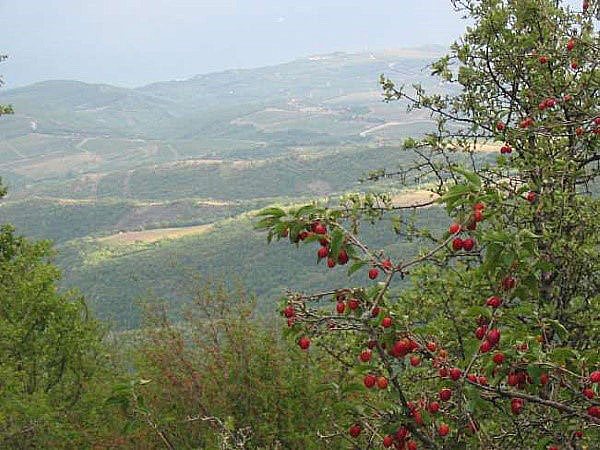

The perennial prefers thermophilic climatic conditions and among the places where dogwood grows, it is worth noting, first of all, the mountain forests of the Transcaucasia, the Caucasus and Transcarpathia. Also, a lot of wild-growing dogwood is observed on the territory of the Crimea. In the indicated area, the culture has the most optimal conditions in which it bears fruit successfully.
The persistent nature of a perennial does not prevent it from growing even among rocks, however, this leaves an imprint on the appearance of the plant. For example, in Armenia, a dogwood in the form of a short-stemmed low tree looks out directly from the rocky crevices.
On the territory of Russia, perennial is also used everywhere as an ornamental plant, since it has a good overall frost resistance. However, the characteristic nuances of the growing season also require a certain approach to cultivation, especially if it is planned not only to get a beautiful hedge, but also to wait for ripe red berries.
Dogwood blooms very early, and the harvest ripens for a long time (more than 200 days).
In this regard, in central Russia, it is better to plant early maturing varieties of dogwood, otherwise the ovary may suffer from recurrent frosts or the berries will not have time to ripen before the onset of autumn frosts.

